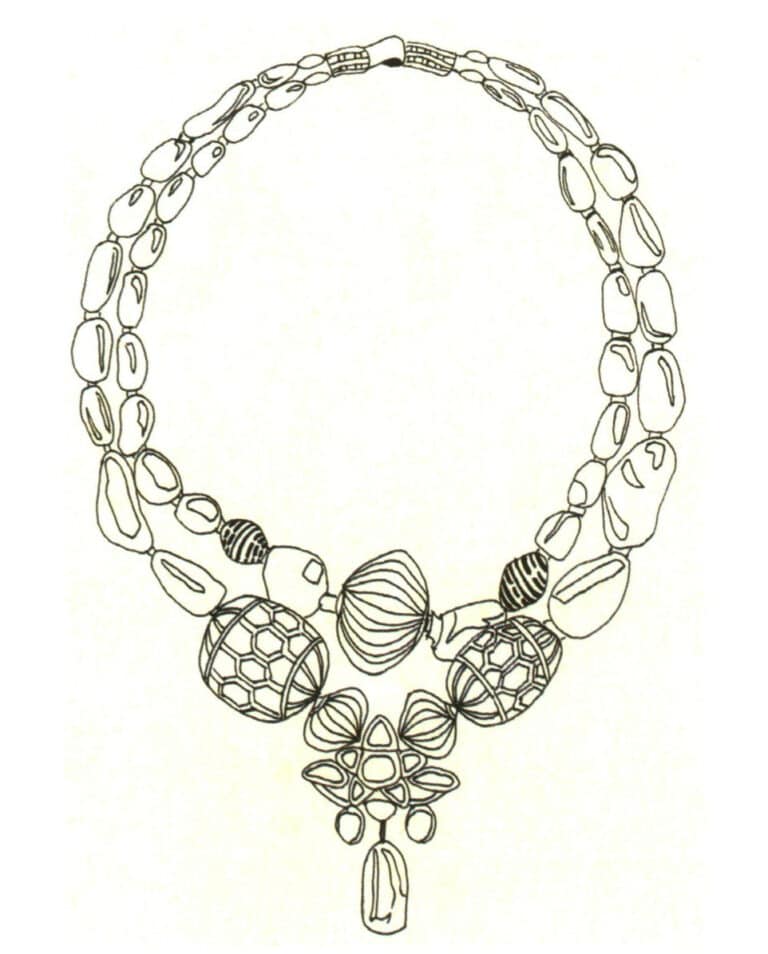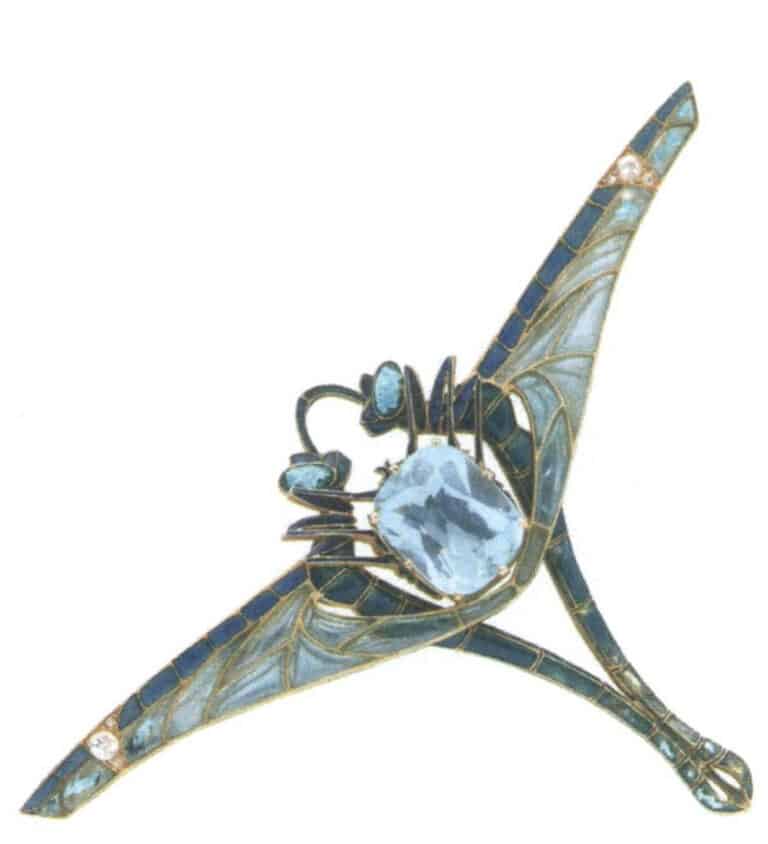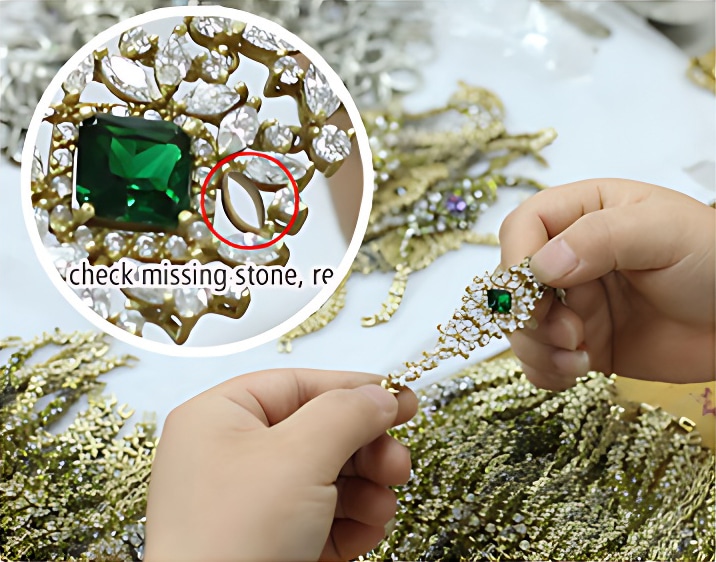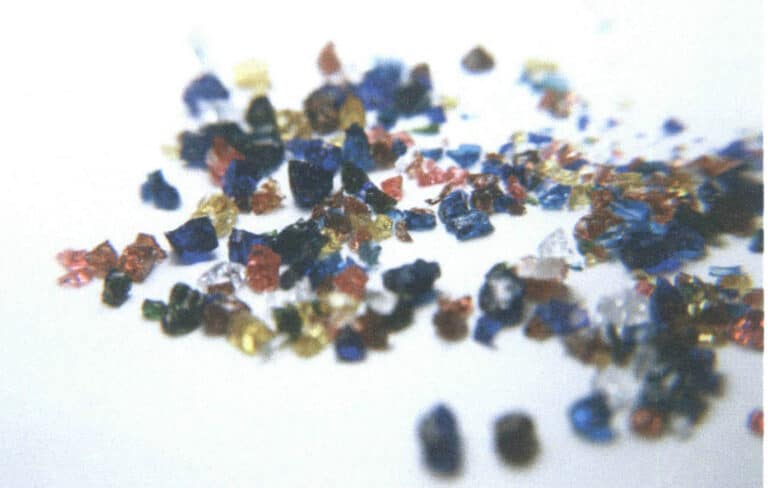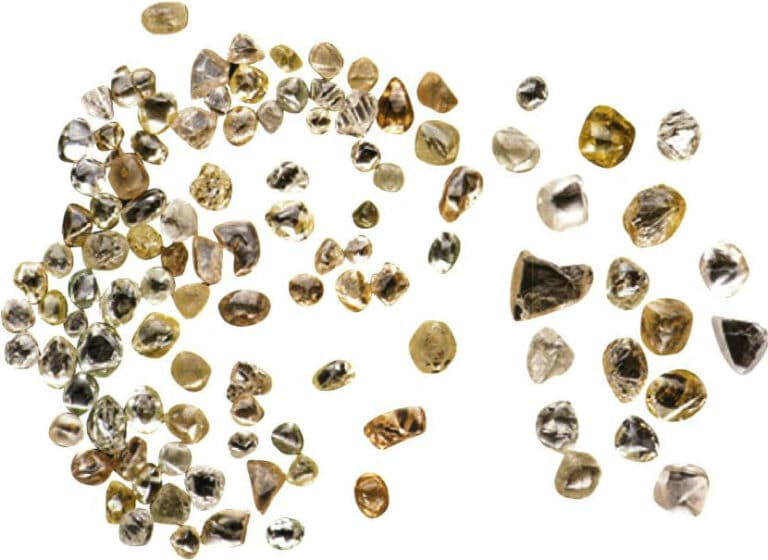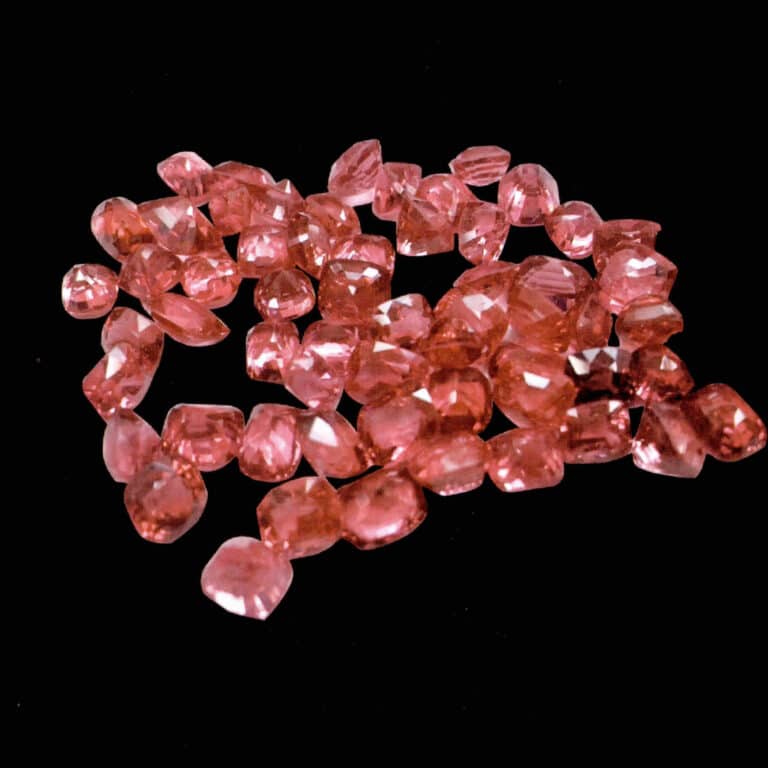Aggregat av ädelstenar: Förstå definitioner, optik och mekaniska egenskaper
Gemologiska grunder relaterade till aggregat
Aggregat var ett av de tidigaste material som människan använde som verktyg. Redan under förhistorisk tid hade människan börjat använda vässad chert för att slakta vilt och hårdare slipmedel för att polera stenar till specifika former och dekorationer, som därmed blev symboler för status och rang. Senare, i och med upptäckten av metaller och utvecklingen av metallsmältnings- och gjuttekniker, ersatte metaller gradvis stenar som det främsta materialet för verktyg, medan stenar fick mer dekorativa funktioner och symbolisk betydelse.
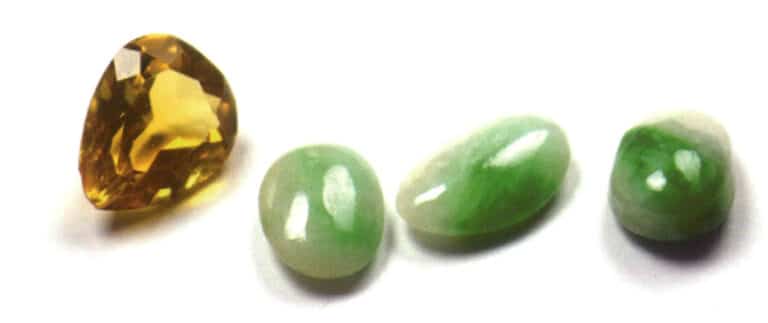
Innehållsförteckning
Avsnitt I Begrepp och beskrivning av ballastmaterial
1. Begreppet aggregat
Aggregat är naturligt förekommande polykristallina mineralaggregat med en viss struktur och sammansättning (Figur 3-1-1). De kan vara aggregat av en enda mineralart eller aggregat av flera mineralarter; de kan vara aggregat av mellan- eller lågvärdiga kristallfamiljer (figur 3-1-2) eller aggregat av högvärdiga kristallfamiljer av mineral.
Ett aggregat är ett polykristallint mineralaggregat som består av en eller flera typer av kristaller med varierande kemisk sammansättning och kristallstorlek. Kristallernas aggregeringsmetod är dock fast för samma typ av aggregat.

Figur 3-1-1 Morfologi för turkosa aggregat
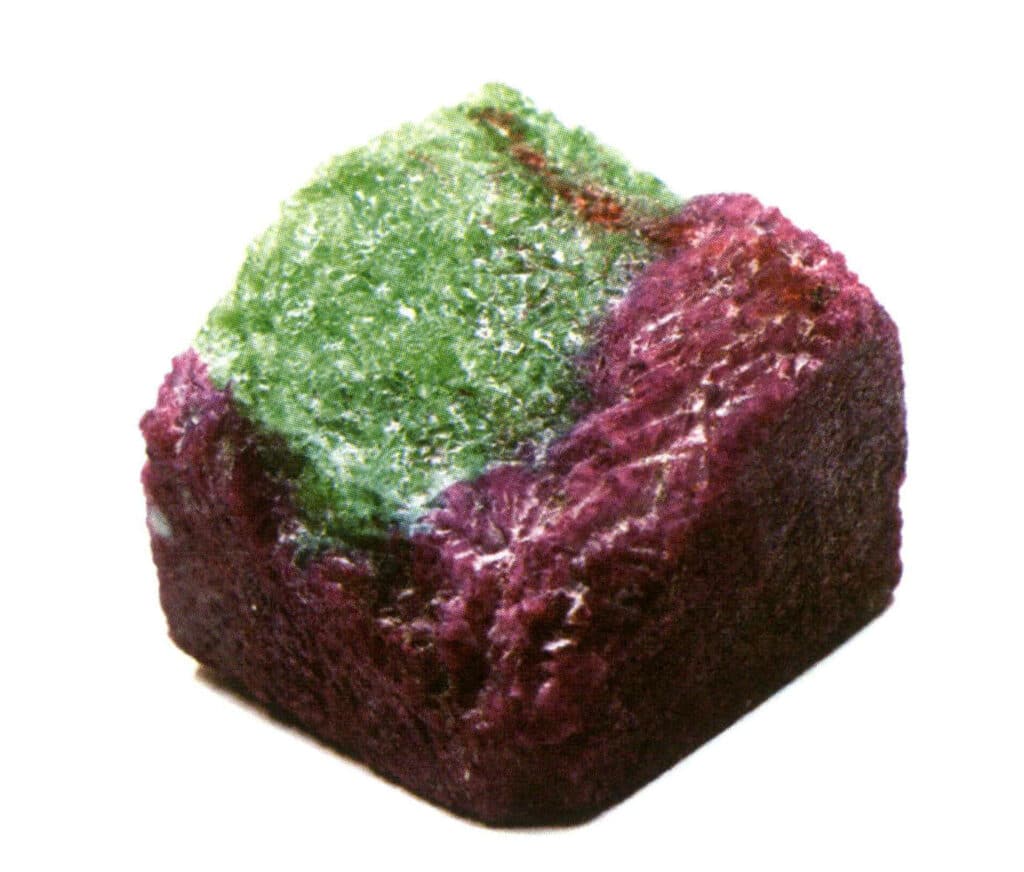
Figur 3-1-2 Rubin och Zoisite (den röda delen är mellanliggande kristallfamilj rubin, och den gröna delen är låg nivå kristallfamilj Zoisite )
2. Beskrivning av aggregatet
På grund av den mångfald av mineraler som utgör aggregatet finns det många sätt att beskriva aggregatet, t.ex. klassificering baserad på storleken och formen på enskilda mineralpartiklar.
2.1 Beskrivning baserad på de ingående mineralernas storlek
Baserat på storleken på de enskilda mineralpartiklarna som utgör aggregatet delas aggregatet in i tre huvudkategorier: kristallisationsaggregat, kryptokristallaggregat och kolloidala aggregat.
Kristallisationsaggregat är sådana där enskilda mineralkristaller kan observeras med blotta ögat eller med ett 10X förstoringsglas.
Kryptokristallaggregatet är en samling enskilda mineralkristaller som endast kan observeras under ett ädelstensmikroskop.
Det kolloidala aggregatet är en samling mineralkristaller som inte kan observeras ens med ett ädelstensmikroskop.
Kryptokristallaggregatet kan långsamt kristallisera under långa geologiska perioder och bilda radiella strukturer, t.ex. den radiella strukturen på tvärsnittet av pyritnoduler, som består av otaliga små nålliknande kristaller arrangerade radiellt. Detta beror på den höga energin i kryptokristallaggregatet, som tenderar att spontant omvandlas till ett kristallint tillstånd med lägre energi.
2.2 Beskrivning baserad på formen hos de ingående mineralerna
Baserat på mineralernas partikelstorlek kan beskrivningen av de ingående mineralernas form delas in i två huvudkategorier: kristallina aggregat och kryptokristallina kolloidala aggregat.
(1) Beskrivning av kristallina aggregat
Kristallina aggregat beskrivs med termer som korniga, flikiga och kolonnformade baserat på formen hos de ingående mineralerna.
① Granulära aggregat.
Denna typ av aggregat är allmänt spridd och bildas genom aggregering av mineralpartiklar med en enda kristall. Partiklarnas form är oftast nära likformig. Beroende på storleken på de enskilda mineralpartiklarna kan de delas in i tre kategorier: Grova korn (partikeldiameter större än 5 mm), Medelkorn (1-5 mm), Fina korn (mindre än 1 mm)
② Fläckiga aggregat.
Mineralpartiklarna i aggregatet är långsträckta i två riktningar, med varierande storlek och tjocklek. Med tanke på aggregatets utseende kan de bilda plattliknande, flingliknande eller fjällliknande aggregat.
③ Kolonnformade aggregat.
Om partiklarna är långsträckta i en riktning bildar de pelarformiga, nålformiga, hårformiga, fibrösa eller buntformiga och utstrålande aggregat. En druse kallas det om dessa kolonnformade kristaller har en gemensam bas och bildar en grupp kristaller av samma eller olika mineral. Bildandet av druser beror på att kristallerna växer maximalt. Lutningsvinkeln mot basen utvecklas lättast. Samtidigt elimineras andra kristaller gradvis på grund av att de hindras under tillväxtprocessen, ett fenomen som kallas den geometriska elimineringslagen.
(2) Beskrivning av kryptokristallina - kolloidala aggregat.
Det kryptokristallina kolloidala aggregatet kan inte urskiljas med blotta ögat eller under ett 10X förstoringsglas på grund av mineralpartiklarnas storlek och kan endast klassificeras och beskrivas baserat på aggregatets övergripande form. Vanliga beskrivande termer inkluderar sekretionskropp, nodulkropp, stalaktitkropp och massiv.
① Sekretionsorgan.
De kallas också kristallkörtlar och är mineralaggregat som fylls med kristallint eller kolloidalt material i hålrum i berget. Denna fyllning börjar från hålrummets vägg och sätter sig gradvis mot mitten. Ofyllda hålrumsväggar ses ofta med druse, såsom agat- och kalcedonaggregat.
Under sedimenteringsprocessen kan fyllnadsmaterialets sammansättning förändras, vilket resulterar i att sekretkroppen har koncentriska skiktstrukturer. Sekretkroppar med en diameter på mindre än 1 cm kallas också amygdaloidkroppar. Porerna i vulkaniska extrusiva bergarter är ofta fyllda med sekundära mineral, vilket ger bergarten en mandelstruktur.
② Nodulkropp.
En sfärisk kropp som gradvis fälls ut och växer inifrån och ut runt ett visst centrum (sandkorn, bubblor av biologiskt skräp), sedimentationsprocessen är exakt motsatsen till den för sekretionskroppar. Noduler bildas i sedimentära berglager och består vanligen av komponenter som fosforit och pyrit. Insidan av nodulerna har i allmänhet också en koncentrisk skiktstruktur.
När diametern på en nodul är mindre än 2 mm och bildar ett konglomerat av många former och storlekar som liknar fiskägg kallas det ett oolitaggregat, t.ex. oolithematit. Aggregat som formas som bönor med en diameter mellan 2-5 mm kallas bönformade aggregat. De med en diameter större än 5 mm kallas noduler, t.ex. pyritnoduler.
③ Stalaktitisk kropp.
Avser ett mineralaggregat som bildas genom avdunstning av en lösning eller koagulering av en kolloid, vilket resulterar i ackumulering av sediment lager för lager. Vanligt förekommande i kalkstensgrottor är stalaktiter, stalagmiter och stalaktiter, som alla tillhör kategorin stalaktiter, och ibland kan stalaktiterna också vara druv- eller njurformade.
④ Blockig kropp.
Ibland är mineralpartiklarna i aggregatet för fina för att man ska kunna urskilja gränserna mellan dem med blotta ögat, och i beskrivningar av handprover kan detta kallas tätblockigt.
2.3 Beskrivning baserad på egenskaperna hos de ingående mineralerna
Mineraler klassificeras ur ett strukturellt perspektiv som kristallina, amorfa fasta ämnen, isotropa kroppar och icke-homogena kroppar ur ett optiskt perspektiv. Efter att ha bekräftat mineralernas egenskaper beskrivs de ofta som isotropa aggregat, icke-homogena aggregat eller amorfa aggregat.
Avsnitt II Förhållandet mellan Jade och aggregatet
1. Den antika förståelsen av Jade
Under antiken skilde man inte mellan ädelstenar och jade, t.ex. kristallkvarts, rubinjade, elfenbenssvart jade och agat, som alla kallas "ädelstenar" på persiska, liksom almandin.
År 1863 kallade Alex D'Amour Hetian-jade för nefrit och feitsui för jadeit.
2. Moderna definitioner
Naturlig jade avser mineralaggregat som produceras av naturen och som kännetecknas av skönhet, hållbarhet, sällsynthet och hantverksvärde, med några få amorfa fasta ämnen. Jade är en speciell typ av sten.
Jade ware avser föremål som är skurna av Jade.
3. Förhållandet mellan himmel, aggregat och stenar
Aggregates and rocks and stones are interchangeable terms; however, aggregates and rocks are technical terms in the academic system, while stones are colloquial expressions.
Jade is a part of the aggregate; its characteristics are beauty, rarity, durability, and craftsmanship value. Aggregates that do not possess these characteristics cannot be called Jade.
In terms of the relationship between Jade, Jadeite, and nephrite that is often discussed in daily life, from a disciplinary perspective, Jadeite and nephrite are varieties of Jade. We define them as Jadeite and nephrite because of their different compositions. Similarly, many specifically named jades belong to Jade but cannot represent all jades.
Section III Definitions of Optical Terms Related to Aggregates
Many optical properties of aggregates will be consistent with those of crystals, but there are also unique aspects. This section will briefly discuss the phenomena observed when viewing aggregates under lighting conditions and the professional terminology used to describe these phenomena.
It should be noted that there are invisible dispersion, pleochroism, and birefringence phenomena in aggregates.
1. The Color of Aggregates
The methods for describing the color of gemstones include standard colorimetric, binomial, and analogical methods. The color description of aggregates often uses the analogical method, for example, the color descriptions of Jadeite such as spinach green and green pepper green. For certain aggregates with uneven color distribution, it is also necessary to point out the phenomenon of color unevenness (Figures 3-2-1, 3-2-2). When describing Jadeite, the term “color root” may also be used (Figure 3-2-3).

Figure 3-2-1 shows the uneven color of rhodonite and rhodochrosite (the left rhodonite is described as brownish-red with black banded and lumped uneven distribution; the right rhodochrosite is described as pink with white banded uneven distribution).
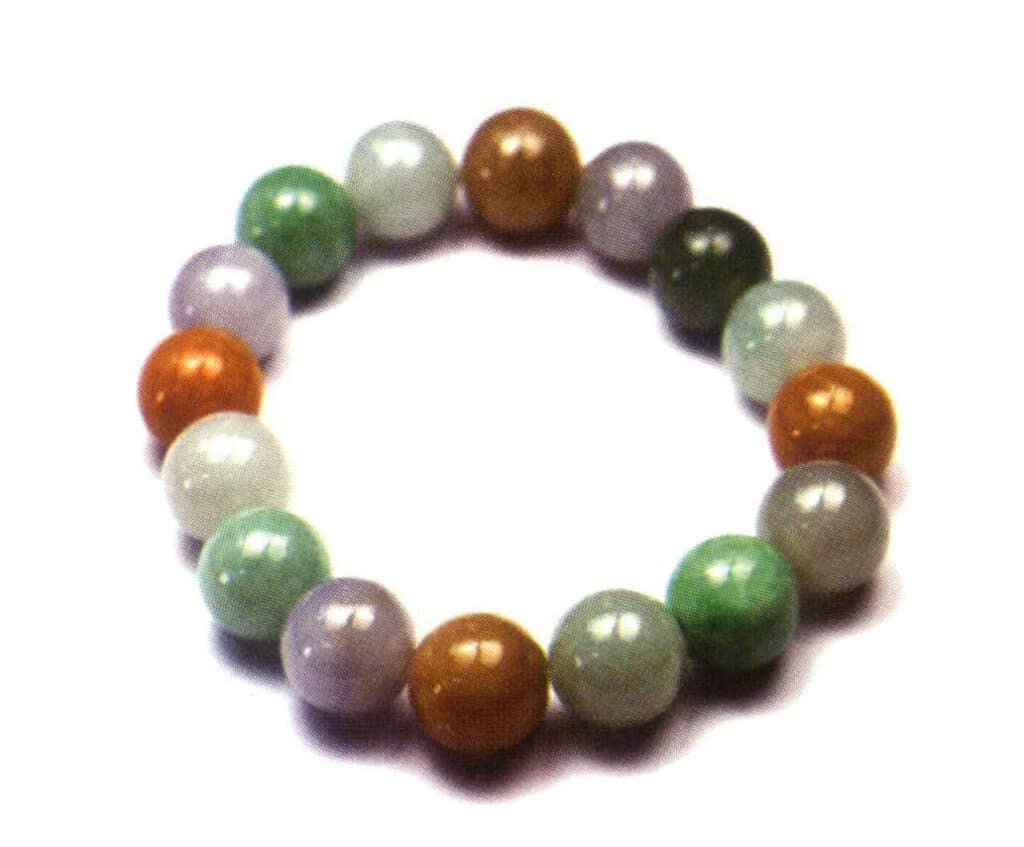
Figur 3-2-2 Färgrik jadeit (De enskilda jadeitpärlorna i armbandet har en mängd olika färger, bland annat grålila, orangegul, oljegrågrön, blågrön och gulgrön. Färgerna på varje pärla är ganska jämna).
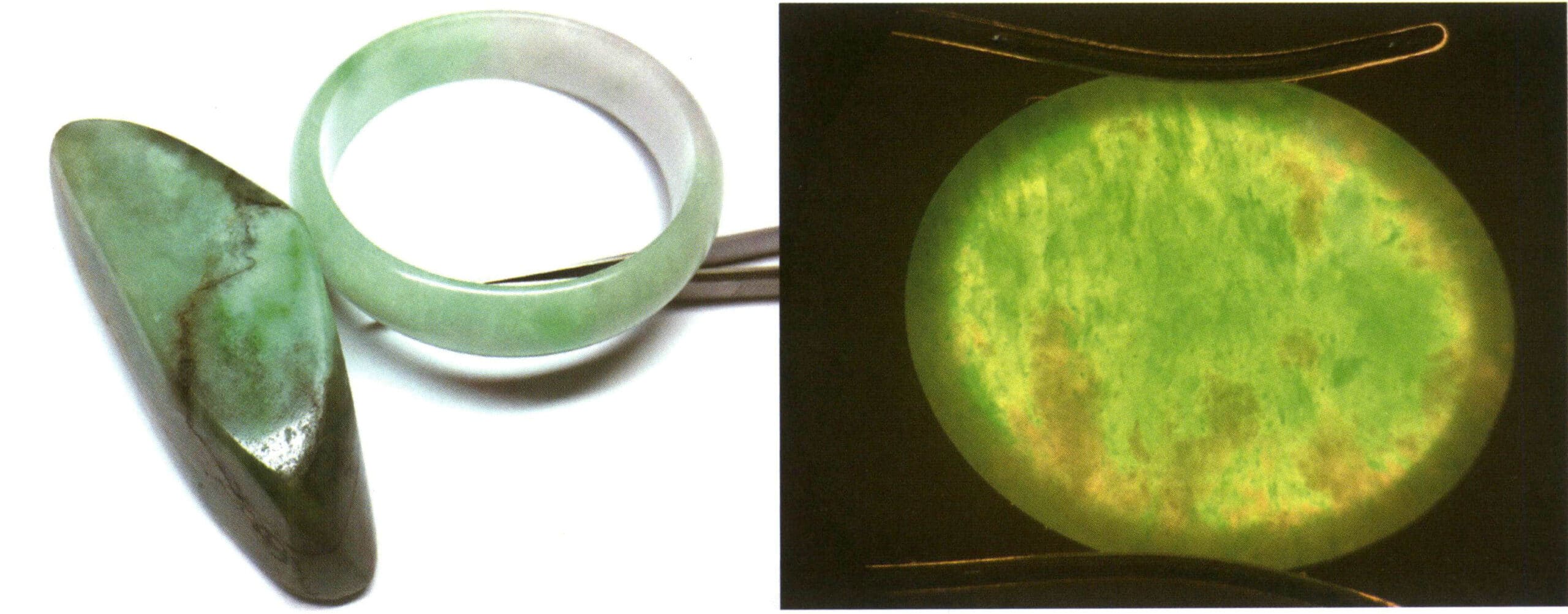
2. Luster of Aggregates
we have already discussed the metal luster commonly seen in crystals, adamantine luster, glassy luster, and oily luster (easily seen in areas where the crystal is damaged). In addition to glassy luster, several types of luster are commonly seen in aggregates. They are oily luster, silky luster, and waxy luster. These types of luster appear in aggregates due to the differences in surface smoothness and aggregation methods compared to single crystals.
If there is a difference in luster on the same aggregate after polishing, it often indicates that the aggregate has been improved (Figure 3-2-4). The difference in luster before and after processing can be significant, based on actual observation; for example, Jadeite is often described as having a luster ranging from glassy to oily.
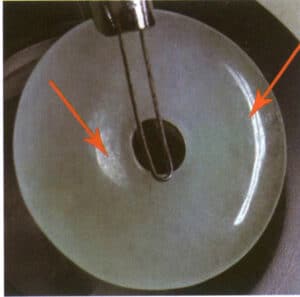
2.1 Oily luster
In aggregates, greasy luster can be seen in materials such as nephrite and some jadeite, similar to applying a layer of oil on the surface of the Jade (Figure 3-2-5 to Figure 3-2-7).

Figure 3-2-5 Oily gloss (nephrite, reflected light)
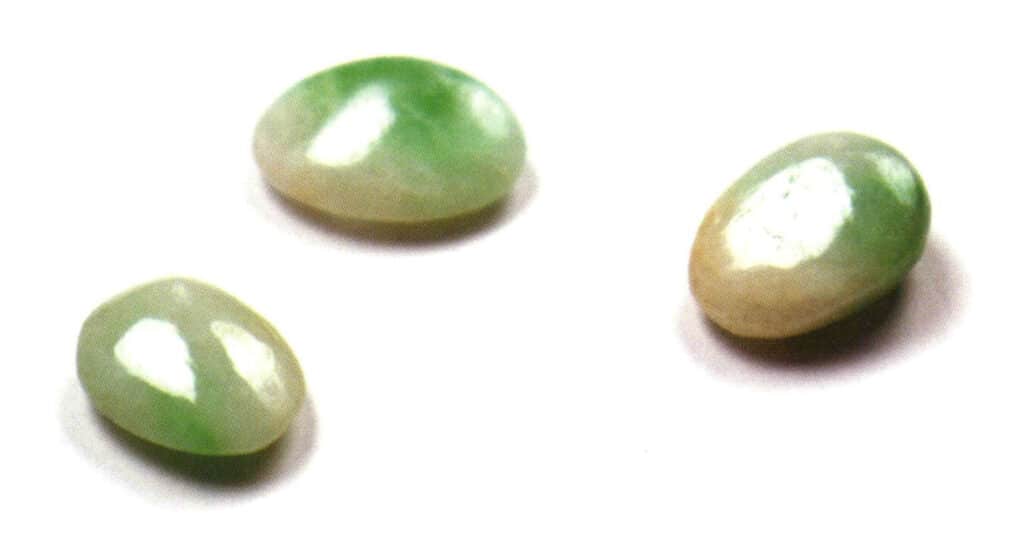
Figure 3-2-6 Glassy and oily gloss (Jadeite, reflected light)
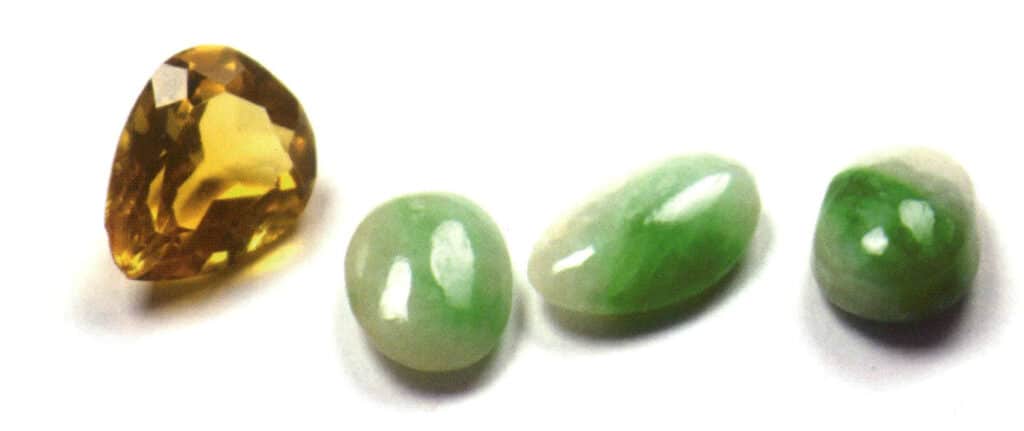
Figure 3-2-7 Comparison of glassy luster (crystal, reflected light) and glass-oily luster (jadeite, reflected light)
2.2 Silky luster
The rough surface of fibrous aggregates often presents a shine similar to silk or silk fabrics. Examples include gypsum, asbestos, tiger’s eye, malachite, and charoite beads(Figure 3-2-8 to Figure 3-2-10).

Figure 3-2-8 Gloss on silk surface (reflected light)
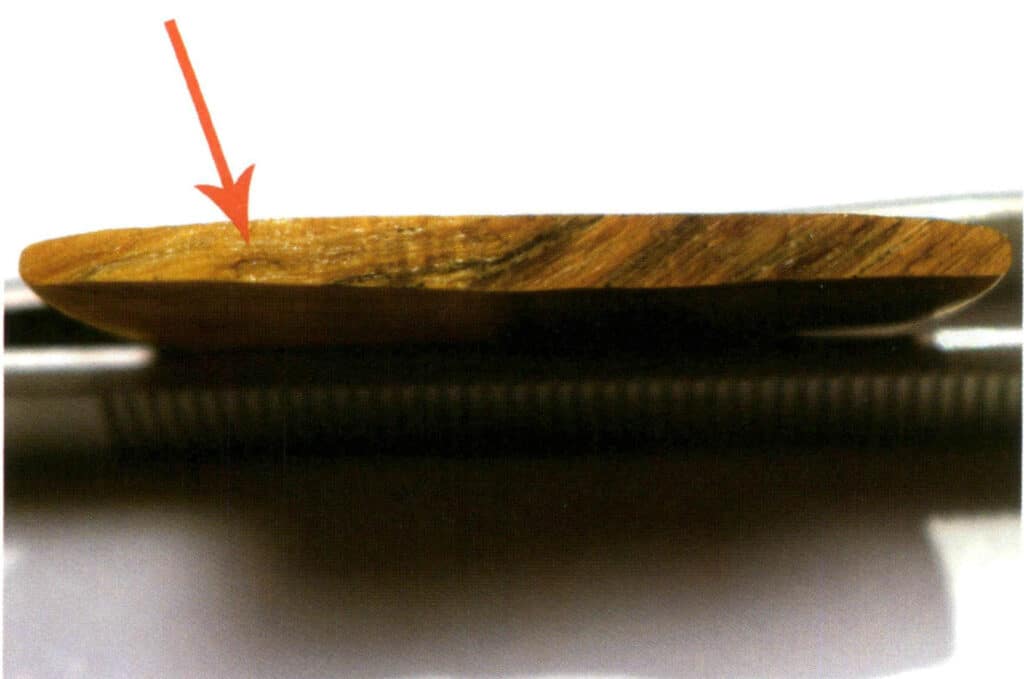
Figure 3-2-9 Silky gloss (at the break of tiger's eye, reflected light)

Figure 3-2-10 Glassy luster (Tiger's eye polished, reflected light)
2.3 Waxy luster
Some transparent minerals exhibit a waxy luster on their cryptocrystalline or amorphous dense masses, such as massive pyrophyllite, serpentine, and rough chalcedony (Figures 3-2-11 to 3-2-13).
Apart from the above situations, aggregates can display two clusters on a single plane due to their constituent minerals’ diversity or inclusions’ influence (Figure 3-2-14).
There is also a type of earthy luster described in minerals (earthy, powdery, or loosely porous aggregates, appearing dull and lacking luster-like clods of Earth. Examples include massive kaolinite and limonite). Currently, there are no gem minerals with this type of luster.
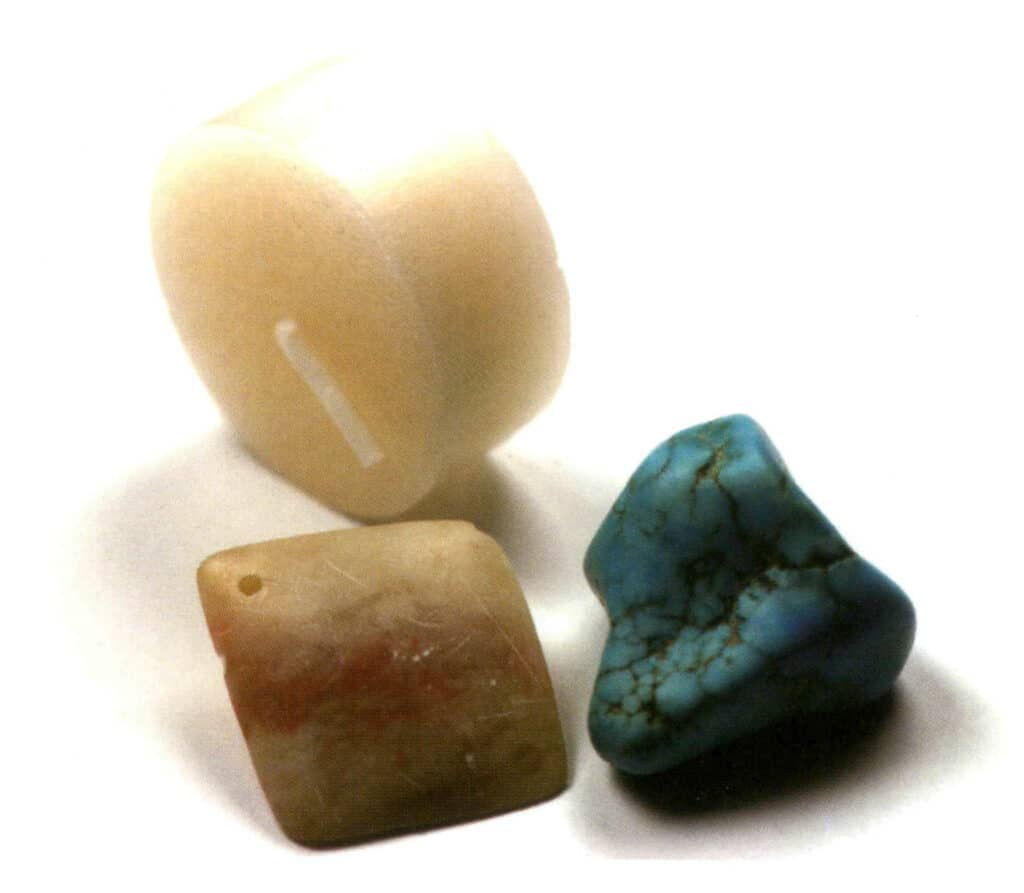
Figure 3-2-11 Waxy luster (top is a candle, bottom left is oriental jasper, bottom right is turquoise, observation condition is reflected light)

Figure 3-2-12 Waxy luster (nephrite, reflected light)
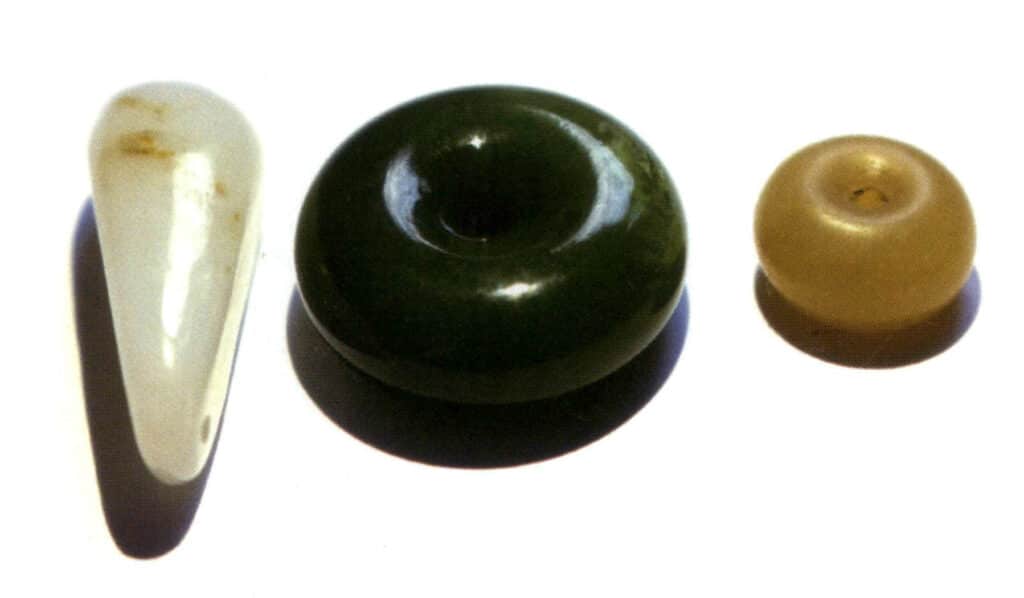
Figure 3-2-13 Comparison of oily gloss and waxy gloss (left one and left two are oily gloss, right one is waxy gloss, the observation condition is reflected light)
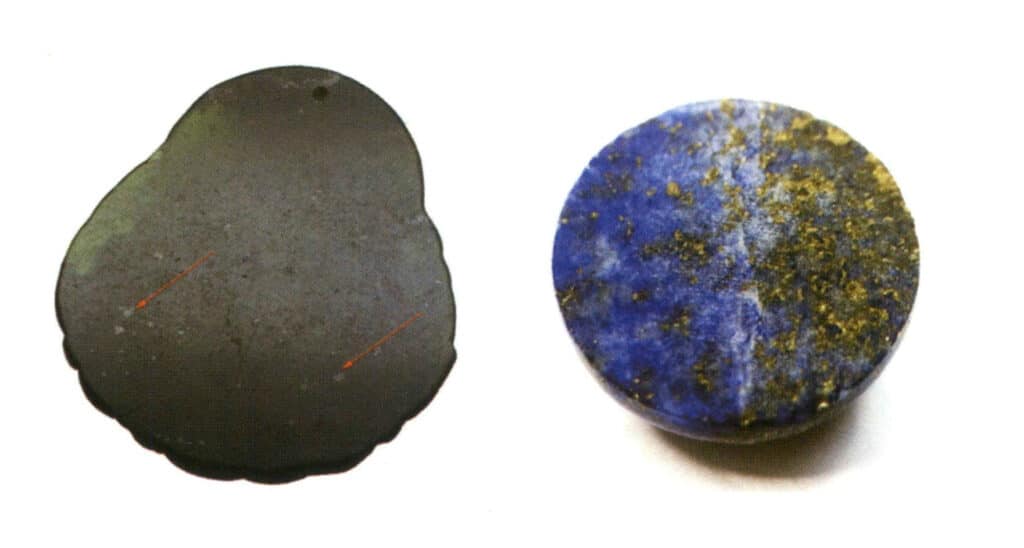
Figure 3-2-14 Under reflected light, the star-point metal inclusions inside the aggregate show a metallic luster. In contrast, the aggregate shows another luster (left is the waxy hsiuyen jade, right is the glassy lapis lazis).
3. Transparency of Aggregates
According to the degree of light transmission of gemstones, transparency is divided into five levels: transparent, semi-transparent, translucent, micro-transparent, and opaque.
The terminology for describing the transparency of aggregates is consistent with that of crystal transparency, and it is observed under reflected light; however, if the transparency of the aggregate is uneven, it needs to be pointed out separately.
The transparency levels commonly involved in aggregates, like crystals, also have five levels.
3.1 Transparent
When the gemstone is observed by transmitted light, the overall brightness of the gemstone is transparent. Compared with the bright background, the brightness of the central part of the gemstone is the same or slightly higher than that of the background, and the edge outline part is darker. Such as jade in glass, albolite jade (also known as water foam), etc. (Figure 3-2-15. Figure 3-2-16). A more visible object on the same side as the transmitted light can be seen through the gemstone.
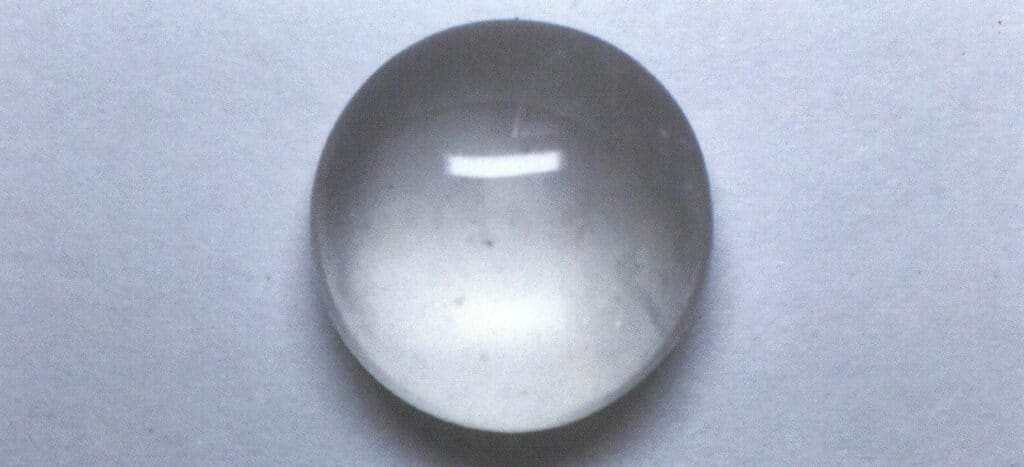
Figure 3-2-15 Albite jade (Reflected light)
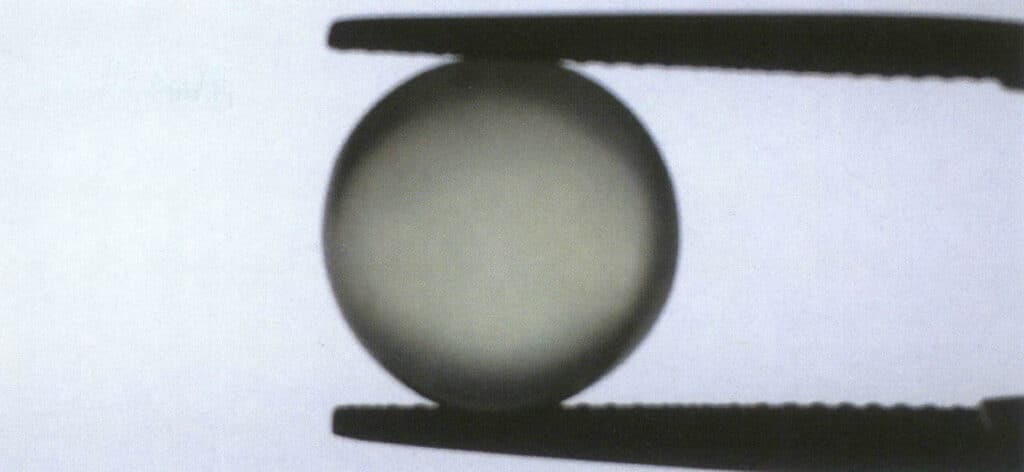
Figure 3-2-16 Transparent (Albite Jade, Transmitted Light)
3.2 Sub-transparent
When observing gemstones with transmitted light, the gemstones appear bright overall. Compared to the background, the brightness of the gemstone is consistent with that of the background. Objects observed on the same side as the transmitted light appear more blurred, as if a layer of dense white gauze has been added between the light source and the transparent gemstone. This is more common in aggregate gemstones and represents the highest transparency of aggregate gemstones, such as icy species jadeite and colorless chalcedony (Figures 3-2-17 to 3-2-20).
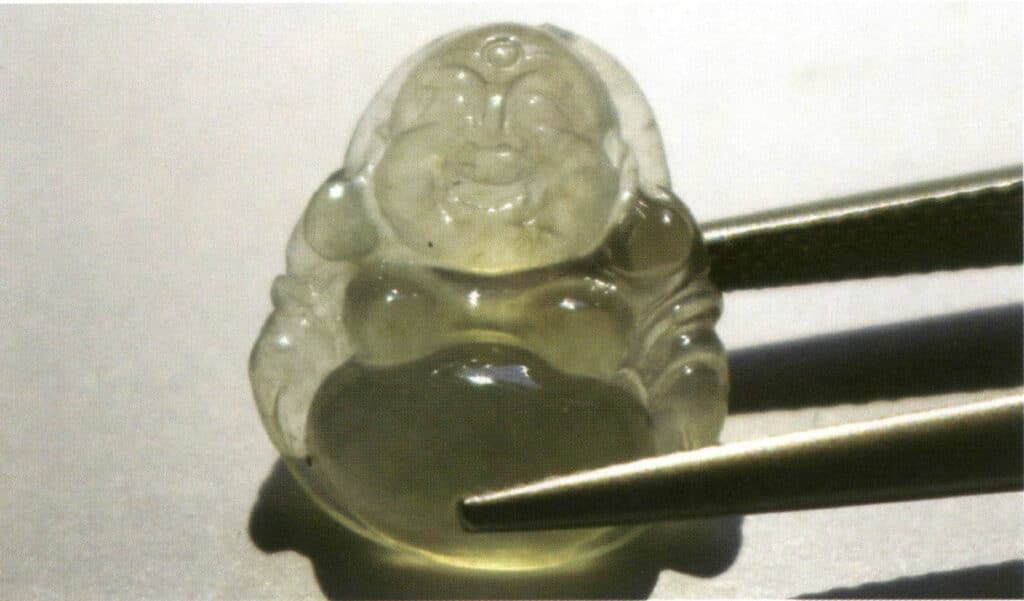
Figure 3-2-17 Jadeite (Reflected Light)

Figure 3-2-18 Sub-transparent (Jade, Transmitted Light)
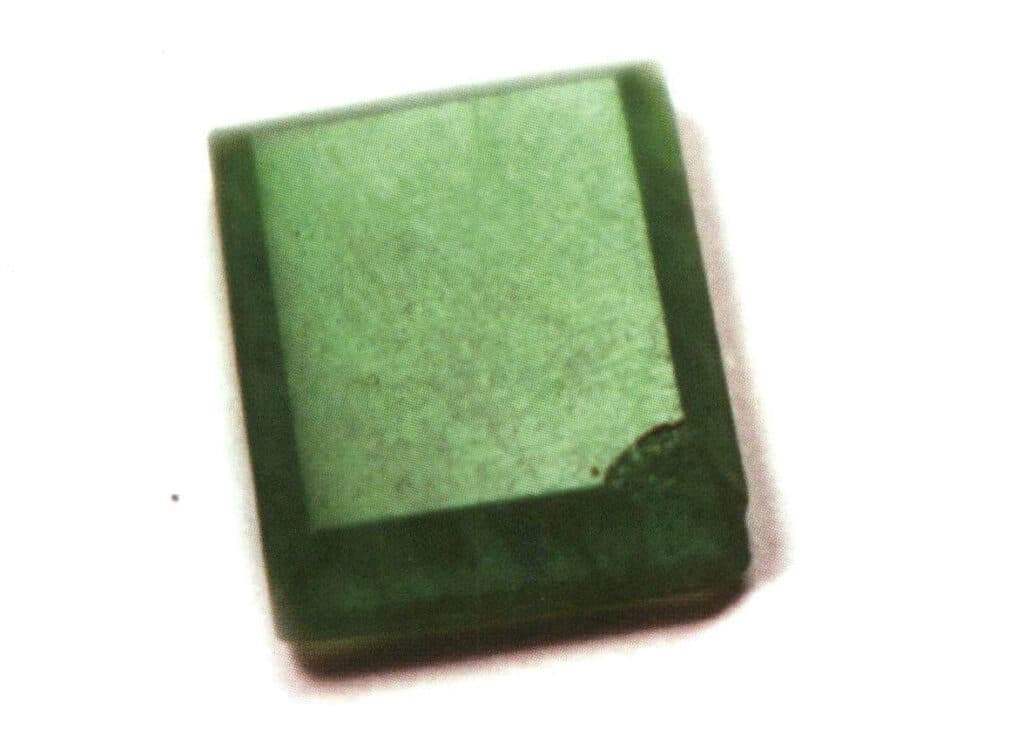
Figure 3-2-19 Quartzite (Reflected Light)

Figure 3-2-20 Sub-transparent (Quartzite, Transmitted Light)
3.3 Translucent
When observing the gem with transmitted light, it appears relatively bright overall, but its brightness is weaker than the bright background. It is more obvious to see objects on the same side as the transmitted light, but it is impossible to determine what the object is; one can only know that there is an object (Figure 3-2-21 to Figure 3-2-25).
3.4 Semi-transparent
When viewed with transmitted light, the gemstone as a whole will light up, but the brightness is significantly darker, and some gemstones will be observed to be darker in the middle and transparent at the edges compared to the bright background (Figure 3-2-26).

Figure 3-2-21 Quartzite (reflected light)

Figure 3-2-22 Translucent (Quartzite, transmitted light)
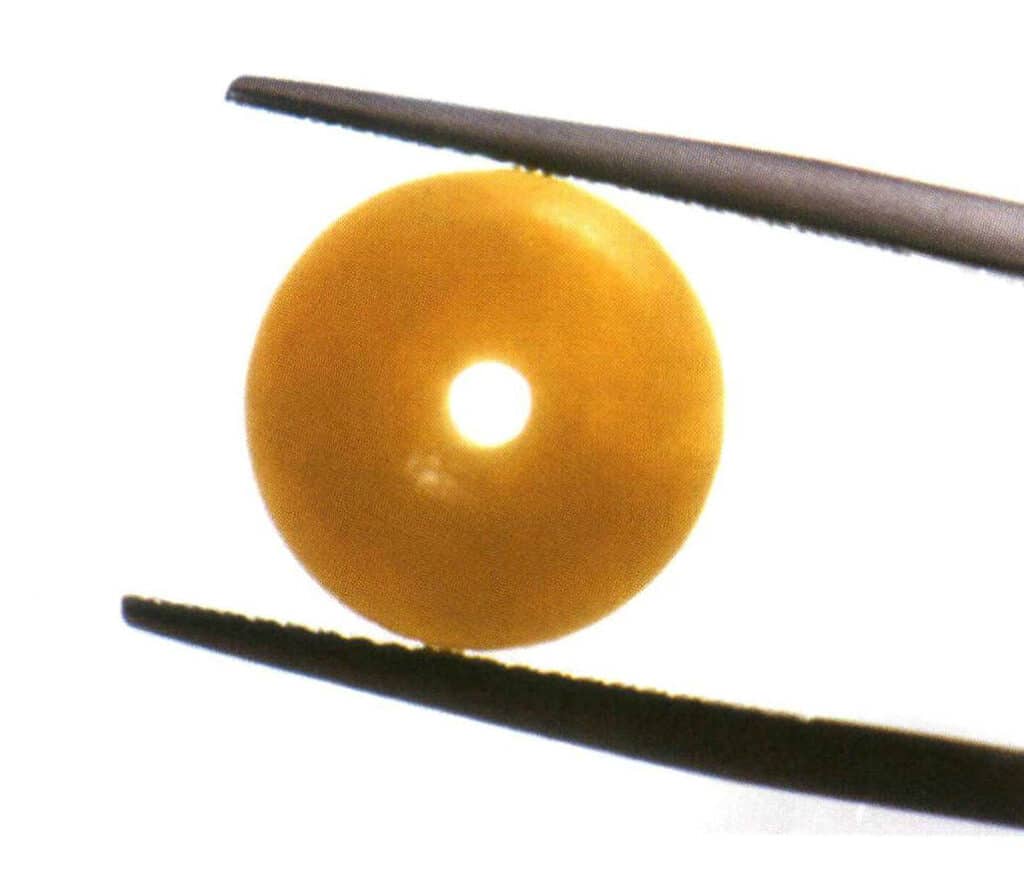
Figure 3-2-23 Translucent (Nephrite, transmitted light)
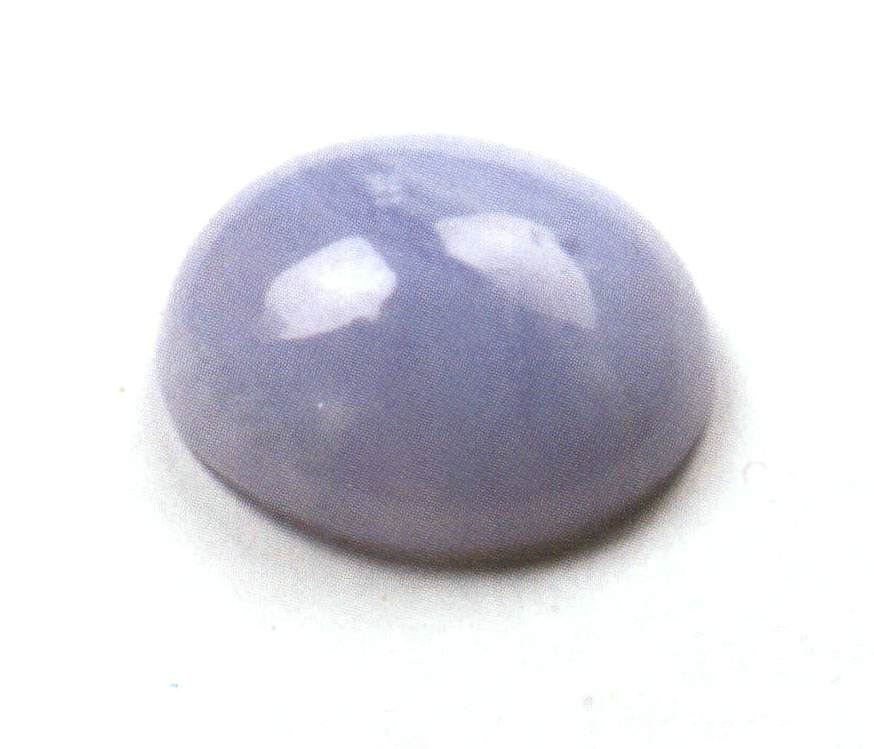
Figure 3-2-24 Chalcedony (reflected light)
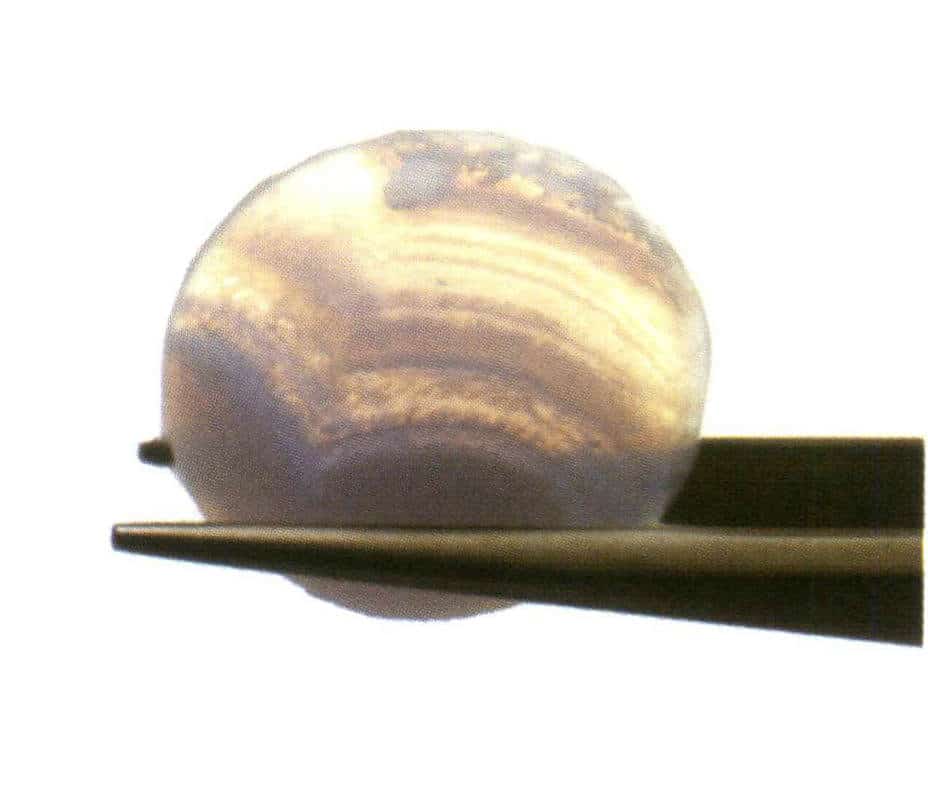
Figure 3-2-25 Sub-transparent to translucent, uneven transparency (chalcedony, transmitted light)
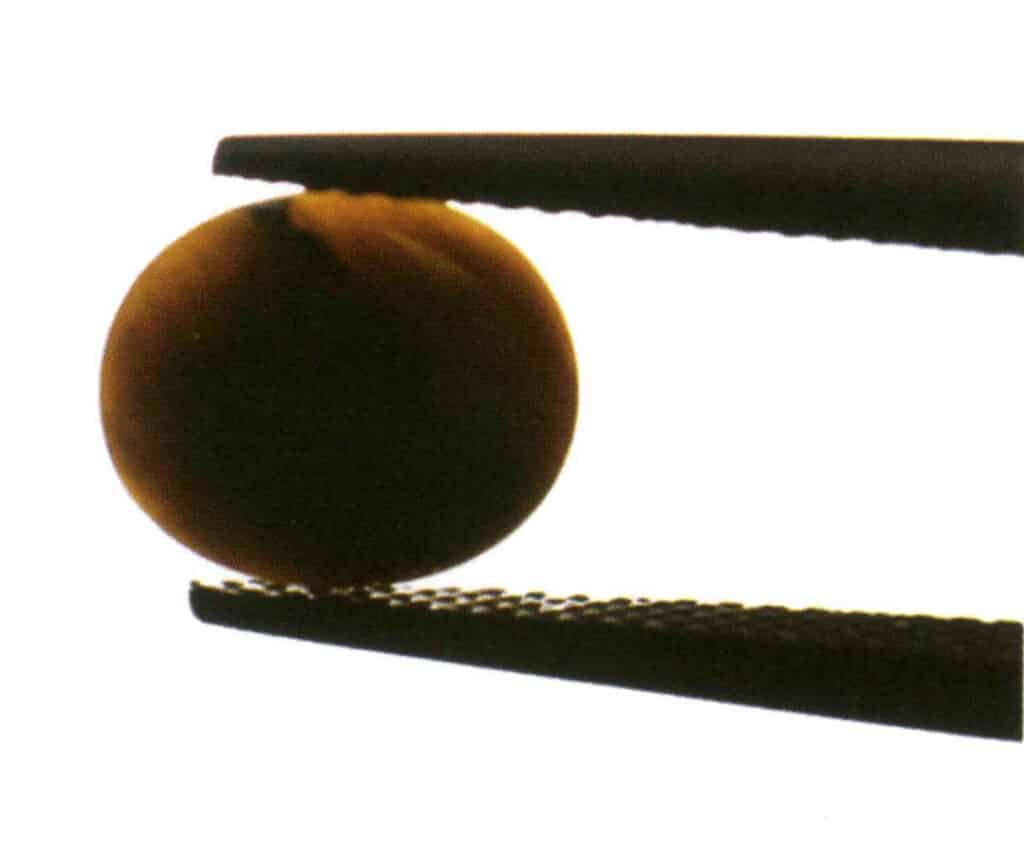
Figure 3-2-26 Slightly transparent (tiger's eye, transmitted light)
3.5 Opaque
When observing the gem with transmitted light, the gem is overall opaque, appearing relatively bright against the background, with bright edges and other areas appearing black or not allowing light to pass through (Figures 3-2-27 to 3-2-30).

Bild 3-2-27 Turkos (reflekterat ljus)

Figure 3-2-28 Opaque (turquoise, transmitted light)
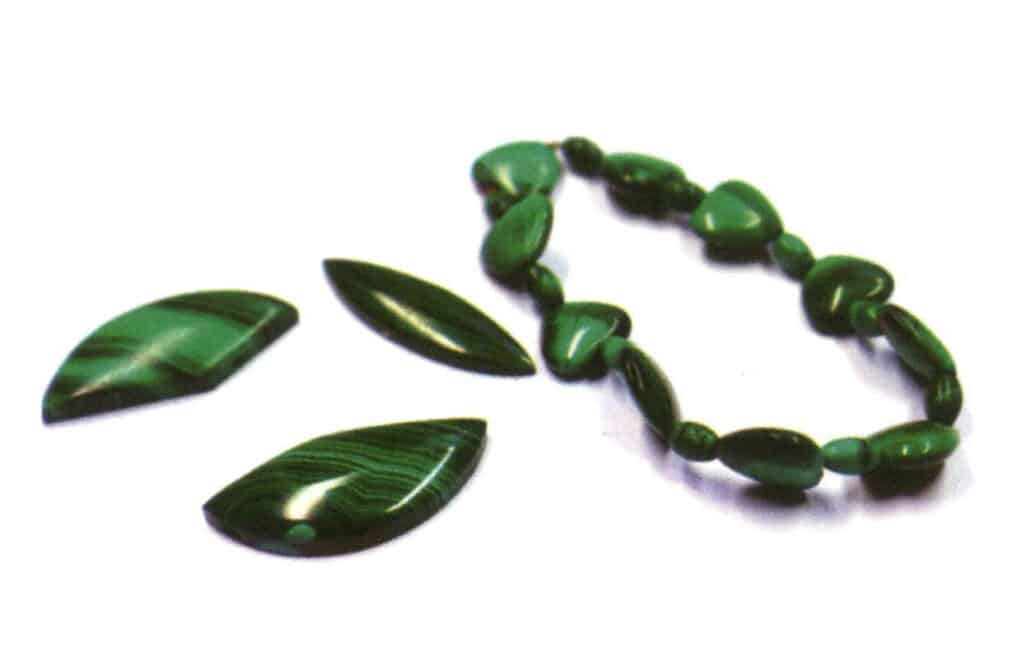
Figure 3-2-29 Opaque (Malachite, transmitted light)

Figure 3-2-30 Opaque (Lapis Lazuli, transmitted light)
Copywrite @ Sobling.smycken - Anpassad smyckestillverkare, OEM och ODM smyckesfabrik
4. Luminescence of Aggregates
The format for describing the luminescence of gemstones observed with the naked eye is intensity and color, where intensity can be described using the following terms: strong, medium, weak, and none. Color description can use any of the standard colorimetric methods, binomial method, or analogy method.
The luminescence of aggregates is generally not observable to the naked eye. Like crystals, luminescence is usually invisible if the aggregate contains iron elements (Figures 3-2-31 to 3-2-33). It is particularly important to note that when observing under ultraviolet fluorescent light, the uniformity of the fluorescence should be described, as the luminescence of individual minerals constituting the aggregate may vary (Figures 3-2-34 to 3-2-36).
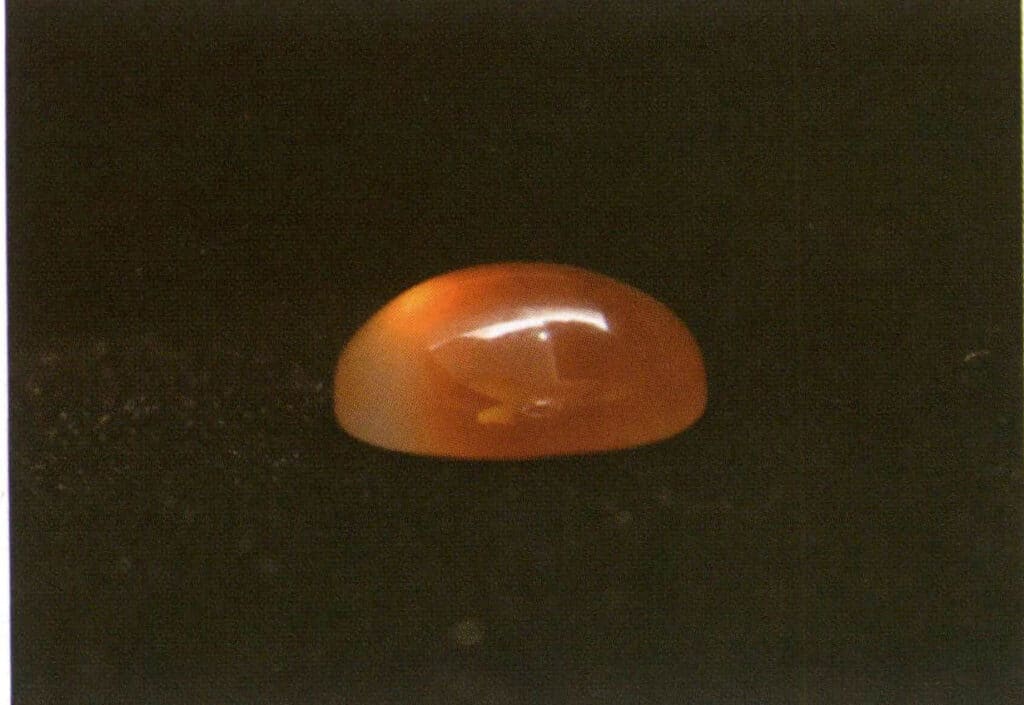
Figure 3-2-31 Agate under normal light source (containing iron elements).

Figure 3-2-32 Agate shows no fluorescence under long-wave ultraviolet light, not visible to the naked eye.
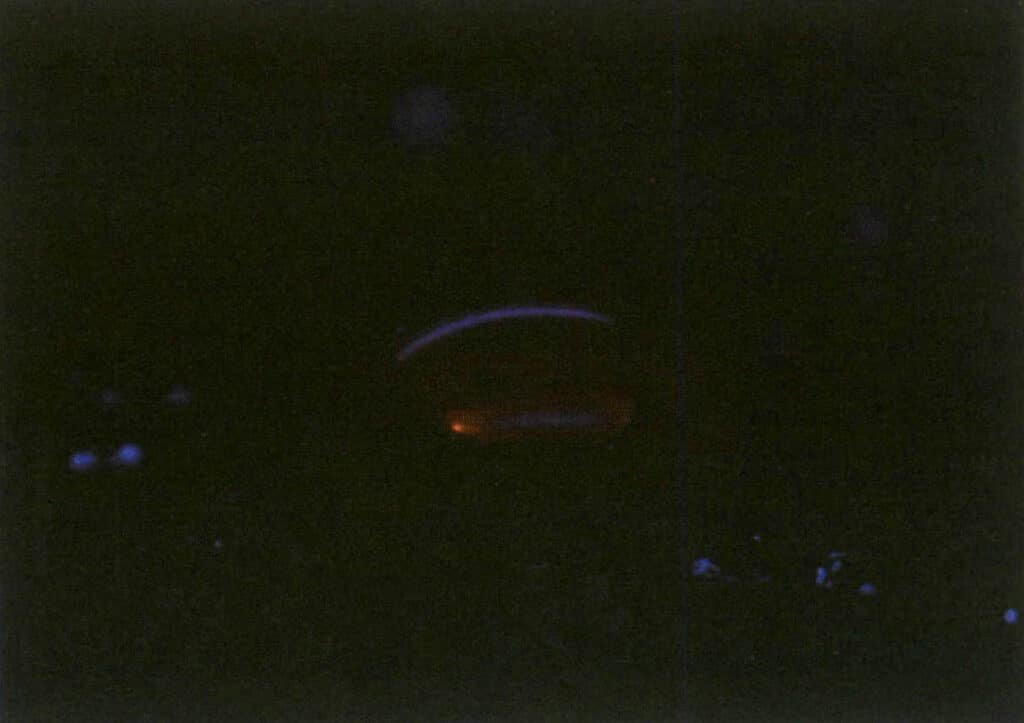
Figure 3-2-33 Agate shows no fluorescence under short-wave ultraviolet light, not visible to the naked eye.
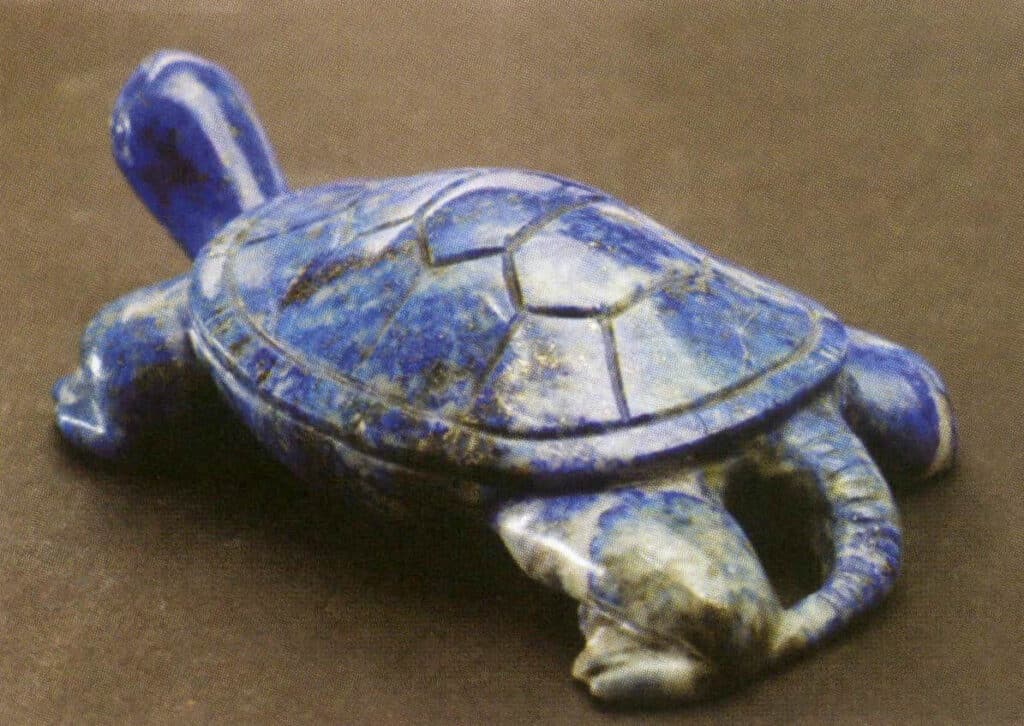
Figure 3-2-34 Lapis lazuli under normal light.
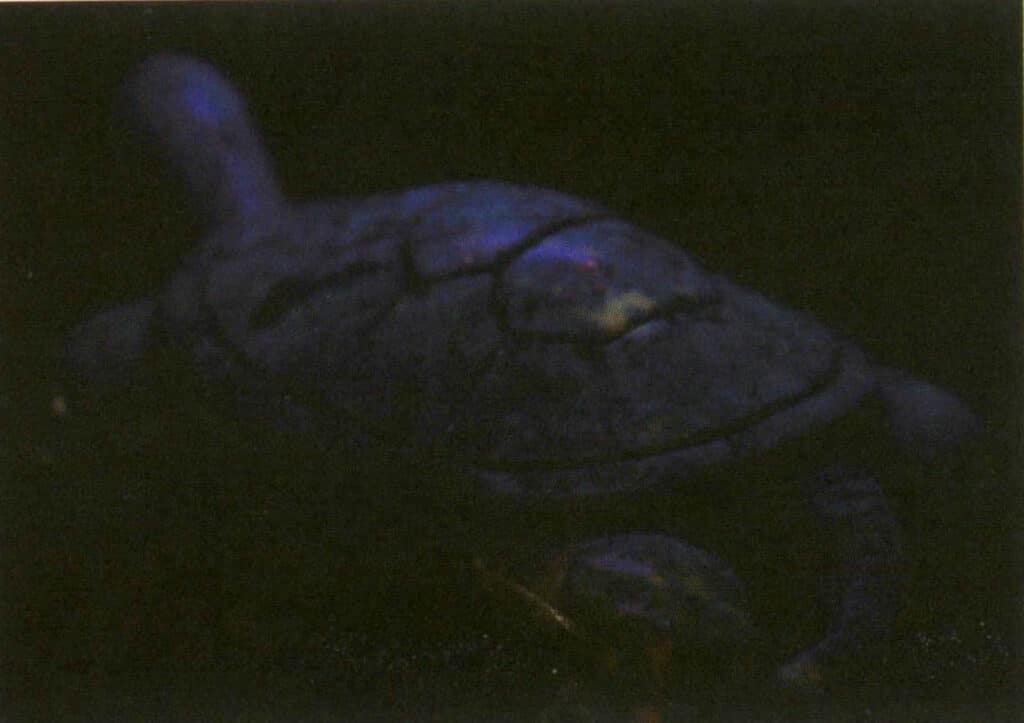
Figure 3-2-35 Under long-wave ultraviolet fluorescent light, blue fluorescence (of lapis lazuli) is not visible to the naked eye.
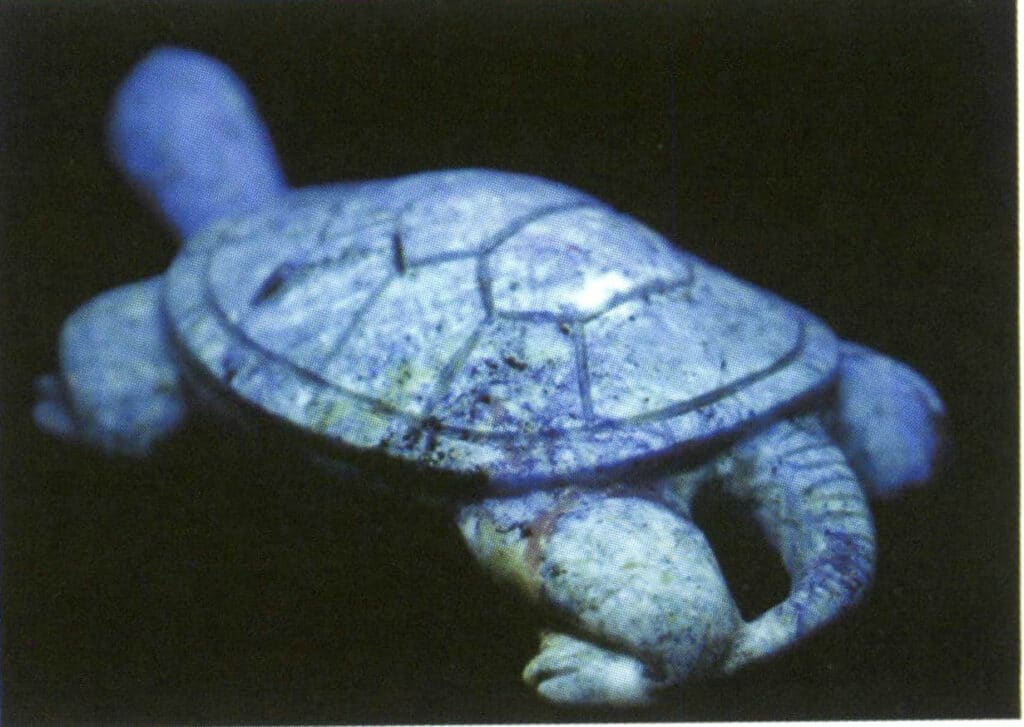
Figure 3-2-36 Under short-wave ultraviolet fluorescent light, uneven chalky fluorescence (of lapis lazuli) is not visible to the naked eye.
Here, we will briefly discuss a common type of aggregate in the market—Jadeite’s fluorescence.
Natural Jadeite generally does not have fluorescence. If Jadeite is filled with organic substances such as epoxy resin, some jadeite can even show obvious blue-white fluorescence under strong light without the need for ultraviolet light (Figures 3-2-37, 3-2-38). Accurately identifying this phenomenon can help us distinguish some bleached and filled Jadeite in the market.


For most jadeite, fluorescence must be observed with ultraviolet light, but fluorescence does not prove that jadeite has been bleached and filled. In general, fluorescence in jadeite requires the exclusion of purple jadeite, coarse granular structure jadeite, and no organic matter attachment (such as cosmetics, sweat stains, etc.) to determine jadeite’s bleaching and filling treatment.
In actual observation, a phenomenon called “fluorescence reflection” can easily be confused with fluorescence. When illuminated by reflected light, some finely structured, transparent to semi-transparent natural Jadeite will show a white halo near the edge of the background on the high protruding arc surface of the Jadeite. This phenomenon is called “fluorescence reflection” (Figure 3-2-39).
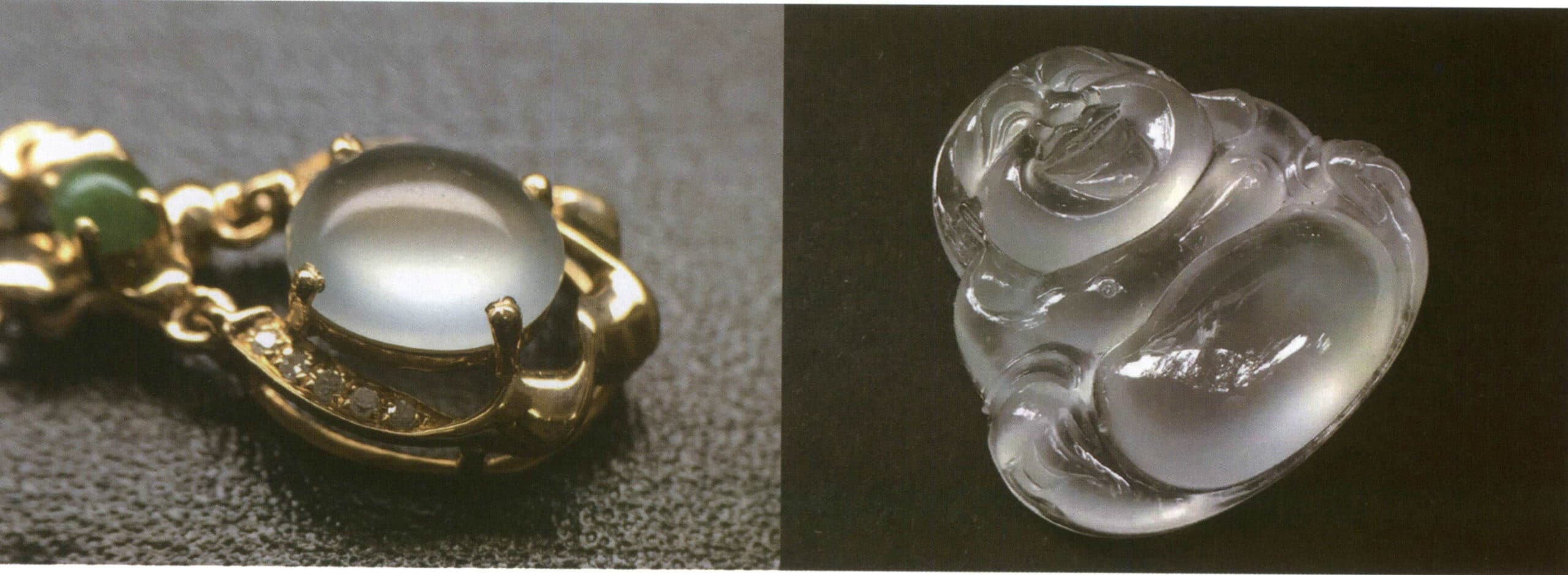
The reason for “fluorescence” is that when parallel incident light passes through the curved surface of Jadeite, it converges on the upper curved surface due to refraction and then converges again on the lower curved surface due to reflection. When it is blocked by mineral particles inside the aggregate, scattering/diffuse reflection occurs.
In the market, Jadeite with an embedded backing will exhibit a similar phenomenon under reflected light (Figure 3-2-40).
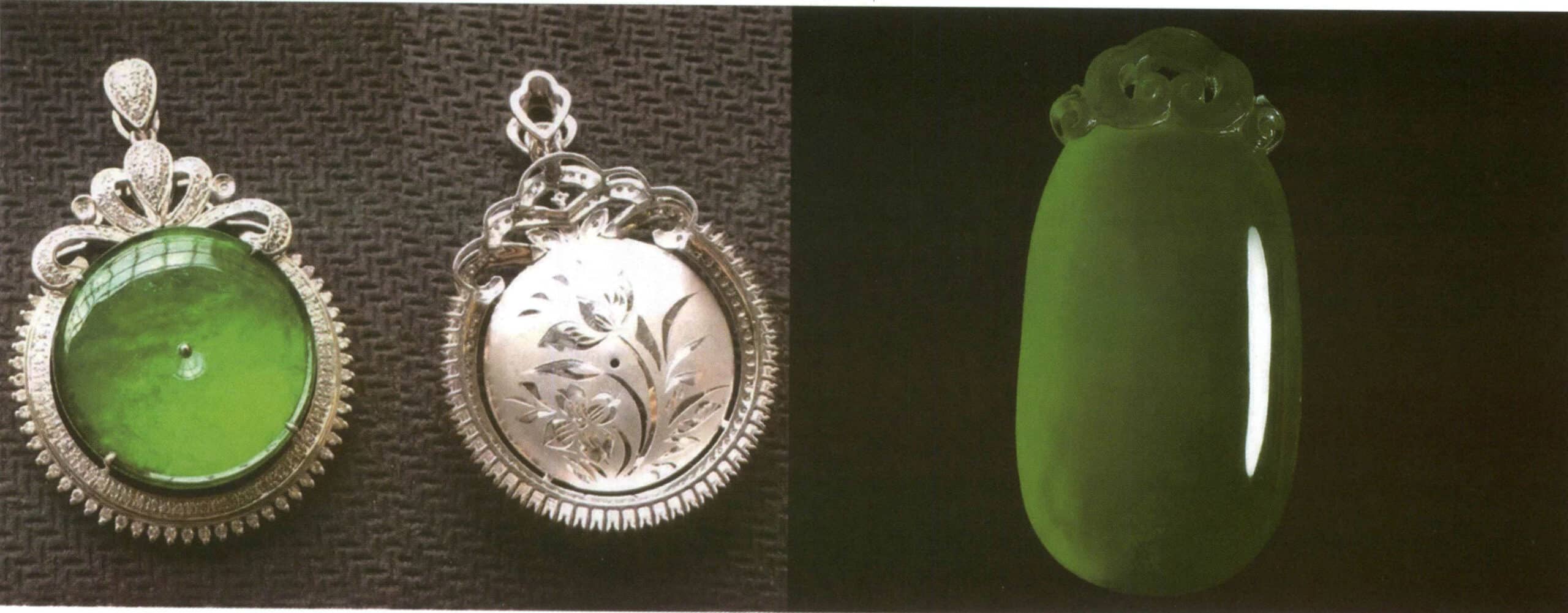
“Fluorescence rise” and the resin fluorescence in bleaching and filling treatments are two different phenomena (Table 1). There is no necessary relationship between “fluorescence reflection” and fluorescence. The phenomenon of “fluorescence” is directly related to the size of the mineral particles that make up the aggregate. When the size of Jadeite’s jade particles is 0.06-0.55mm, the
The “fluorescence” phenomenon may be observed in the Jadeite. From the perspective of jade particle size, Jadeite’s “fluorescence” phenomenon is inversely related to its transparency, meaning that when the “fluorescence” phenomenon is obvious, the transparency is not obvious. The “fluorescence” phenomenon is not obvious when the transparency is obvious.
Table 1: Differences between jadeite fluorescence and “fluorescence reflection.”
| Analysis of fluorescence causes | Location of fluorescence | Observation Method | |
|---|---|---|---|
| The jadeite with fluoresce | Jadeite attached to organic matter will exhibit fluorescence regardless of color, shape, structure, etc. | The fluorescence strength is based on what is observed for the entire Jadeite. | Except for some bleached and filled treatments, Jade can be observed under strongly transmitted natural light; otherwise, it must be observed under ultraviolet light. |
| After bleaching Jadeite, a resin treatment is performed to make the structure dense, and some may also undergo dyeing treatment later. | |||
| Coarser jadeite, with individual mineral particles forming an aggregate. | The entire Jadeite may exhibit uneven fluorescence due to the minerals that make up the Jadeite, with the strength of the fluorescence being based on observation. | ||
| Purple jadeite | |||
| "Fluorescence reflection" Jadeite | The structure must be fine, transparent to translucent, and have a curved surface; all three conditions are indispensable. This phenomenon can be seen in Jadeite with a certain thickness or in thinner Jadeite with a backing. It can also appear in other stones with similar visual characteristics, such as prehnite (Figure 3-2-41), chalcedony (Figure 3-2-42), and albite jade (Figure 3-2-43) | "Fluorescence reflection " appears in the steeper curved surface areas for Jadeite with a certain thickness. For thinner Jadeite with a backing, "fluorescence reflection " appears in the flatter, gentler areas of the Jadeite. | Observe under reflected light. The intensity of the Jadeite's color, the polishing condition, and the degree of curvature will all affect the prominence of the "fluorescence reflection " phenomenon. |

Figure 3-2-41 Prehnite showing "fluorescence reflection" under reflected light.
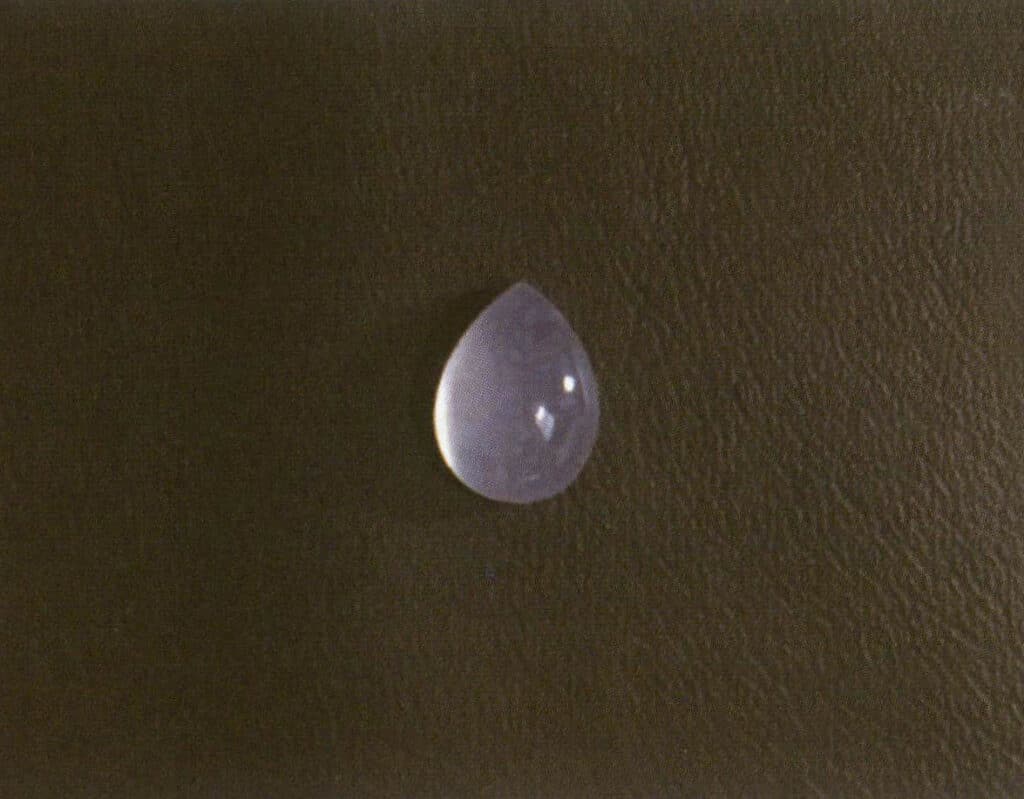
Figure 3-2-42 Chalcedony showing "fluorescence reflection" under reflected light.
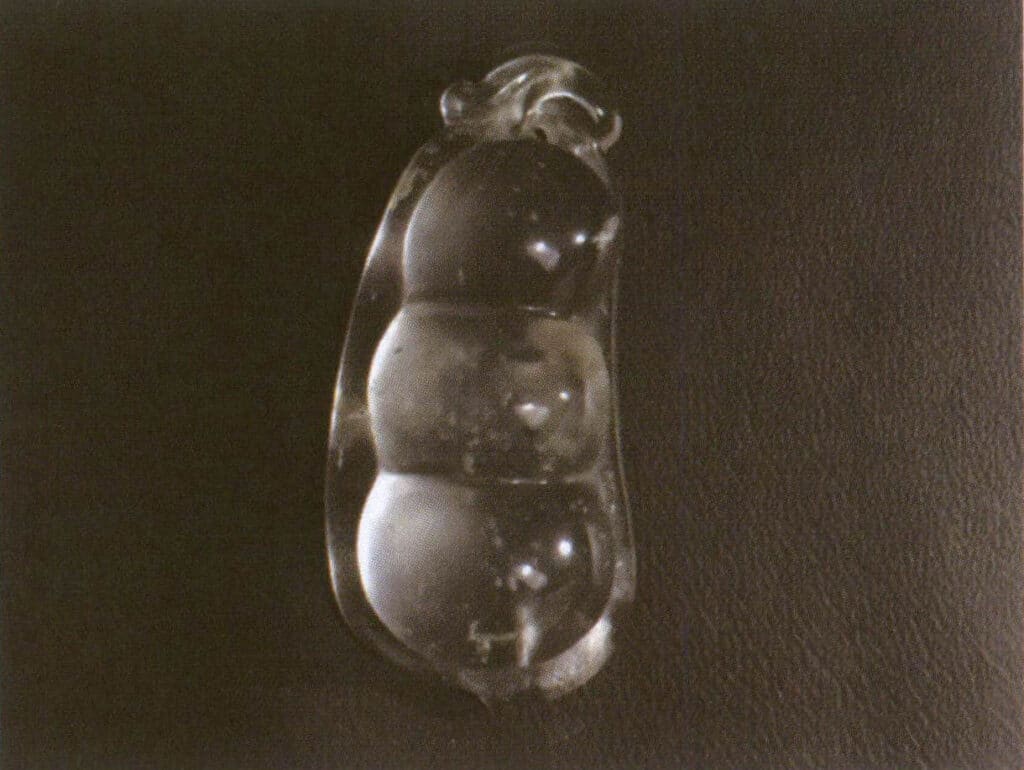
Figure 3-2-43 Albite jade showing "fluorescence reflection" under reflected light.
5. Special Optical Effects of Aggregates
The special optical effects of gemstones include the cat’s eye effect, star effect, color change effect, gold sand effect, color change effect, moonlight effect, and halo effect, totaling seven types. Some textbooks refer to the color change effect, moonlight effect, and halo effect as the halo effect. Here, we will focus on the commonly seen cat’s eye effect, gold sand effect, and color change effect in aggregates.
5.1 Cat's Eye Effect
A directionally arranged curved solid aggregates can also exhibit the cat’s eye effect after directional cutting. For example, Figure 3-2-44 compares the movement of the cat’s eye line when the light source moves for the quartz cat’s eye with the cat’s eye effect and Jade (Figure 3-2-45), etc.


5.2 Goldstone Effect
As long as there are opaque and semi-transparent flaky solid inclusions, aggregates can also exhibit the goldstone effect, such as Aventurine. (Figures 3-2-46 and 3-2-47).
It is worth noting that the goldstone effect and the uneven fracture are two similar phenomena; both exhibit star-like flashes, but the goldstone effect is visible on both the rough and polished surfaces of the aggregate before and after processing, while the uneven fracture is only visible at the rough breakpoints of the aggregate.
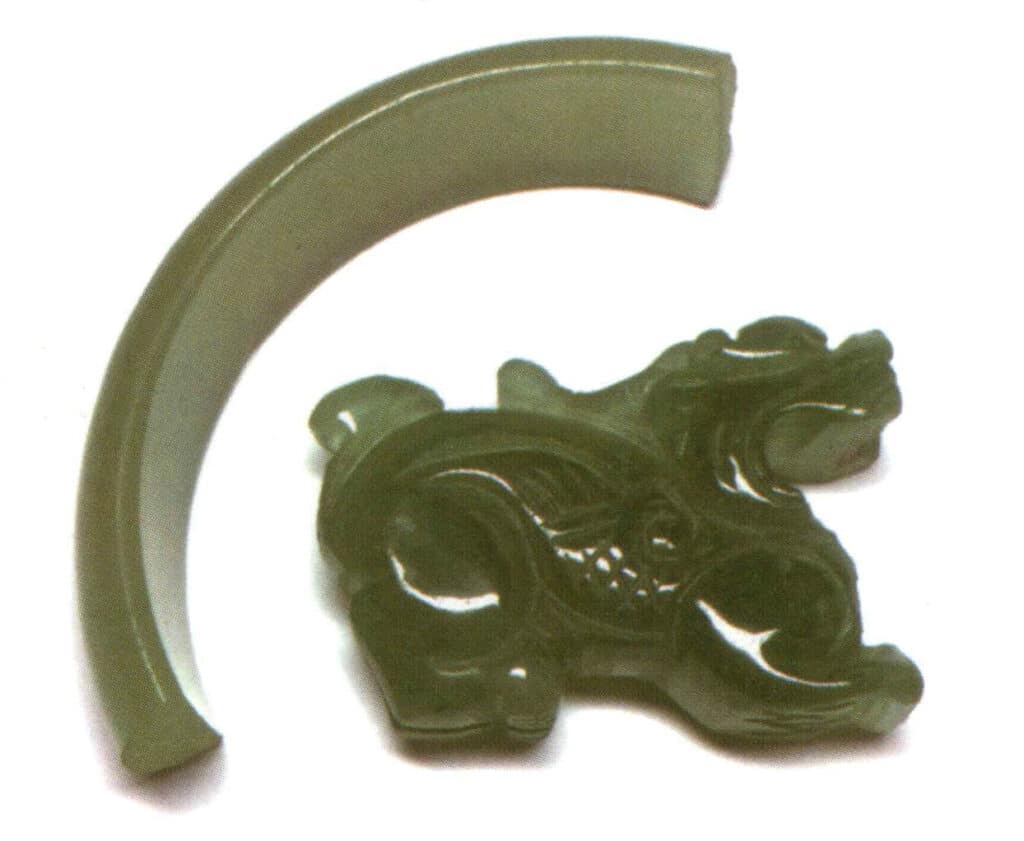
Figure 3-2-46 Aventurine.
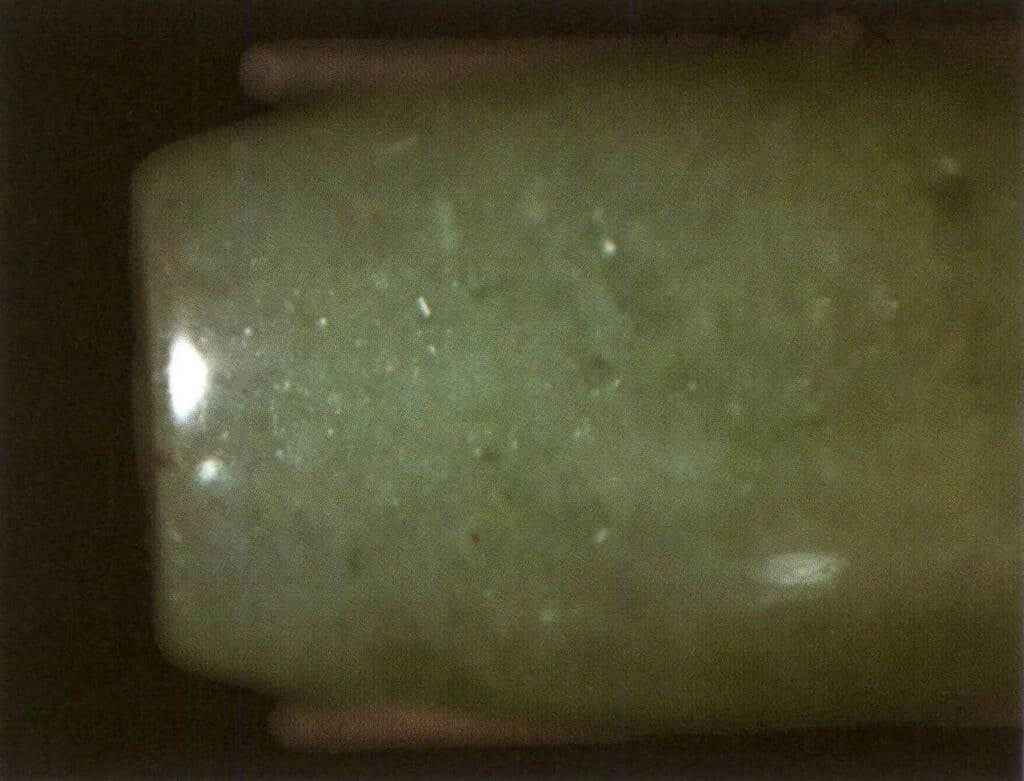
Figure 3-2-47 Sand gold effect of aventurine.
Section IV Interpretation of Mechanical Properties Related to Aggregates
The mechanical properties of gemstones have seven phenomena, divided into four categories: cleavage, parting, and fracture belong to one category, while the other three categories are hardness, density, and toughness. Here, we will discuss cleavage, fracture, hardness, relative density, and toughness related to aggregates.
Cleavage and fracture are the properties of aggregates and the minerals that make up the aggregates that occur under external force, and their fracture characteristics and causes are different. They are one of the important physical properties for identifying and processing gemstones.
1. Cleavage of Aggregates
If the individual mineral crystals that make up the aggregate can exhibit cleavage, then cleavage phenomena can be observed in the aggregate.
The description of cleavage in aggregates is much simpler than in crystals; it only needs to describe whether it is present or absent. In Jadeite, terms like “color” and “fly wing” are also used to describe the cleavage in the Jadeite that makes up Jade. When the jadeite particles are larger than 0.15mm, the color in Jade is visible; when larger than 0.55mm, the color is very obvious (Figures 3-3-1, 3-3-2).
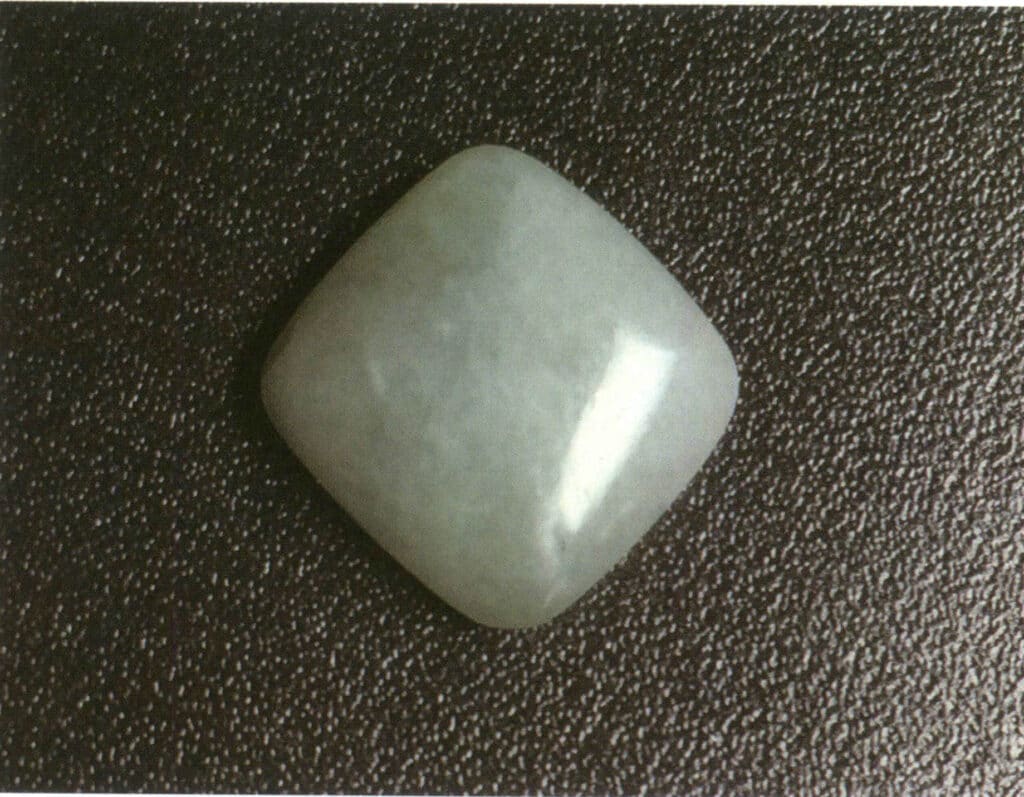
Figure 3-3-1 Jade (reflected light)
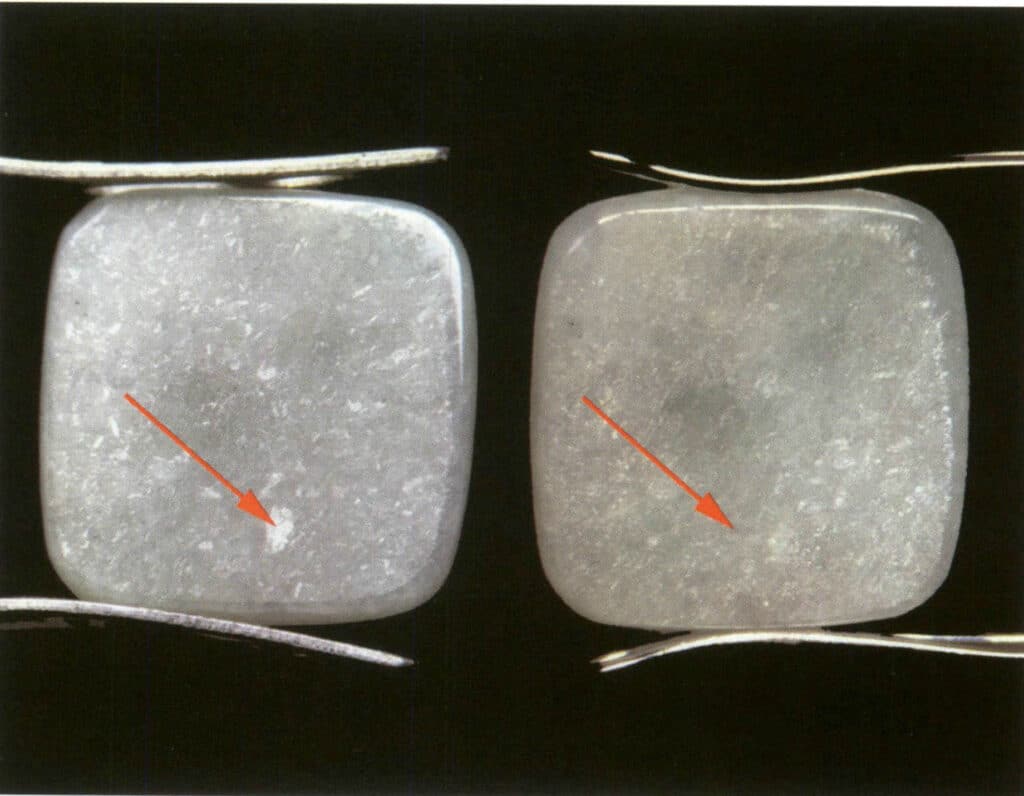
Figure 3-3-2 Observing Jade under reflected light at an angle, the phenomenon of irregular contours flashing in a direction is called "color" (in the right image, after the Jade is rotated, the flash indicated by the red arrow disappears).
2. Fracture of Aggregates
Fracture descriptions often use analogy, usually relying on common phenomena in life to describe the shape of the fracture.
The assembly uses two types of words, jagging and flaky fibers, and this fracture is easy to see in the assembly before processing, as well as the place where the engraving and polishing of the assembly after processing can also be seen.
A jagged fracture refers to an uneven and rough surface. For example, aventurine, etc. (Figure 3-3-3).
A fibrous multi-layered fracture has interlaced thin layers, such as nephrite, jadeite, etc. (Figure 3-3-4).
In actual gem identification, observe the flash pattern of the fracture under reflected light. If the flash pattern is typical enough, whether the aggregate has a granular or fibrous interwoven structure can be determined.
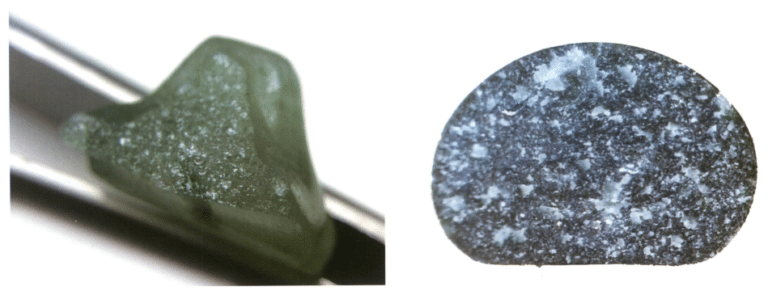

3. Hardness of the aggregate
The hardness of aggregate gemstones is generally above 6, and the aggregate with Mohs hardness lower than six will appear dull and dull due to wear and tear if no attention is paid to maintenance and maintenance in the later wearing process (Figure 3-3-5). In the filling treatment of jade, due to the difference between the hardness of the filling and jade, it is easy to see a phenomenon called acid etching mesh. This phenomenon is also an important visual characteristic distinguishing natural jadeite from filling jadeite (Figure 3-3-6, Figure 3-3-7).
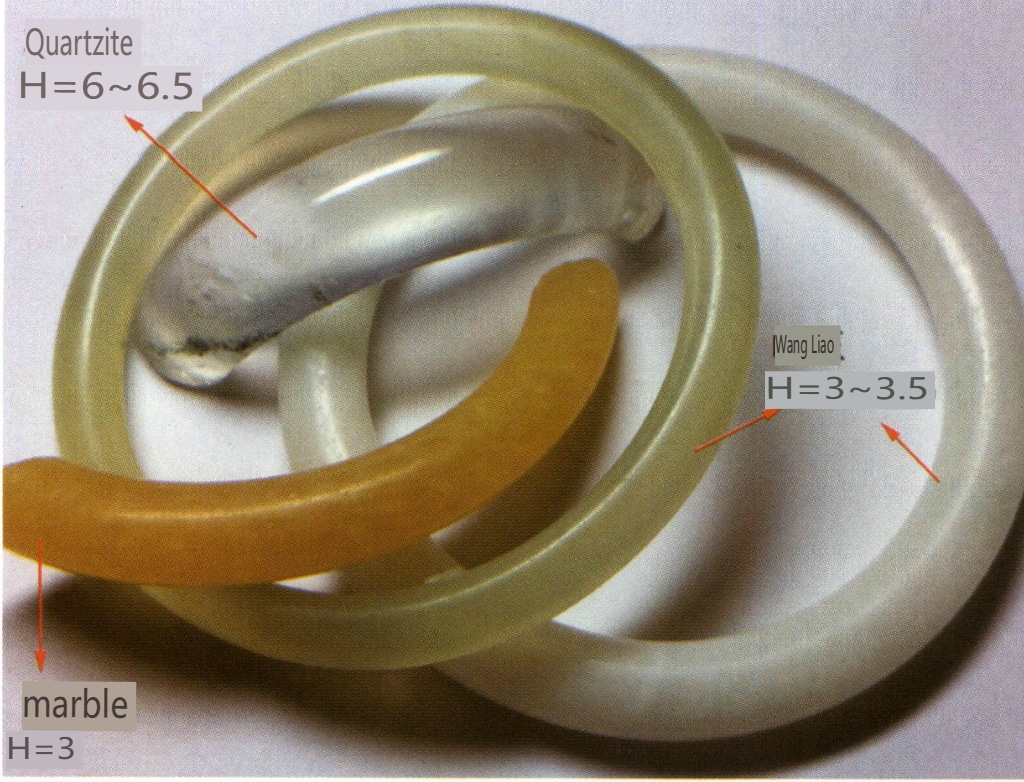
Figure 3-3-5 The different gloss of aggregates due to the varying hardness of constituent minerals under the same polishing conditions
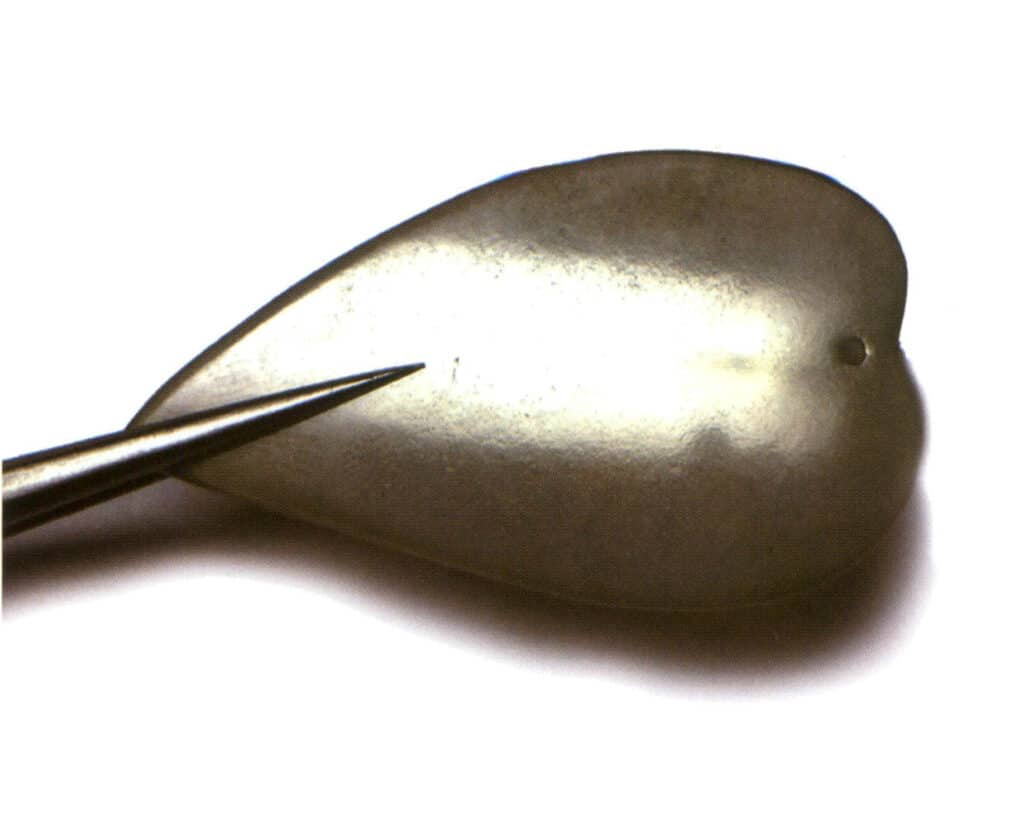
Figure 3-3-6 Natural jade with a smooth surface

Here, it is important to mention a common professional term in Jade: the orange peel effect. By observing the surface of Jade with reflected light at the boundary between the light source and the Jade itself, a phenomenon resembling the uneven surface of the orange peel can be found, referred to as the orange peel effect (Figures 3-3-8, 3-3-9). The orange peel effect is related to the degree of uniformity in the arrangement of the non-homogeneous particles that make up the Jade. Generally, the more disordered the non-homogeneous particles are, the more likely it is to observe varying degrees of smoothness in the polishing, and the greater the difference in hardness, the more likely the orange peel effect will be seen (Figures 3-3-10, 3-3-11).

Figure 3-3-8 Jadeite with a noticeable orange peel effect
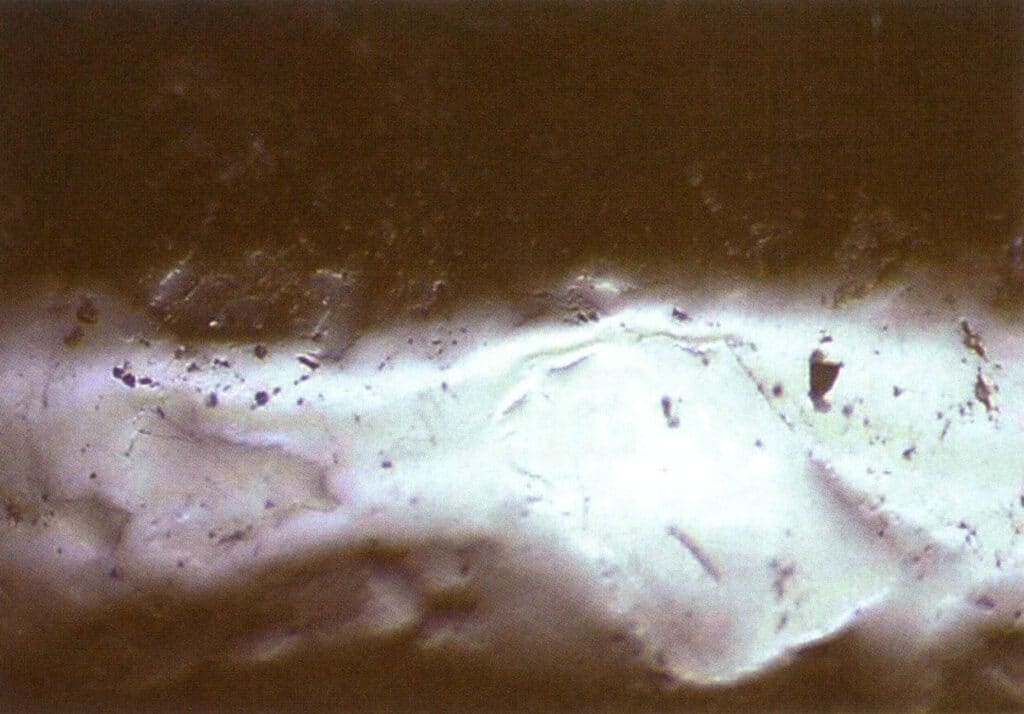
Figure 3-3-9 Orange peel effect of jadeite under 30 times magnification under microscope

Figure 3-3-10 Jadeite with an inconspicuous orange peel effect
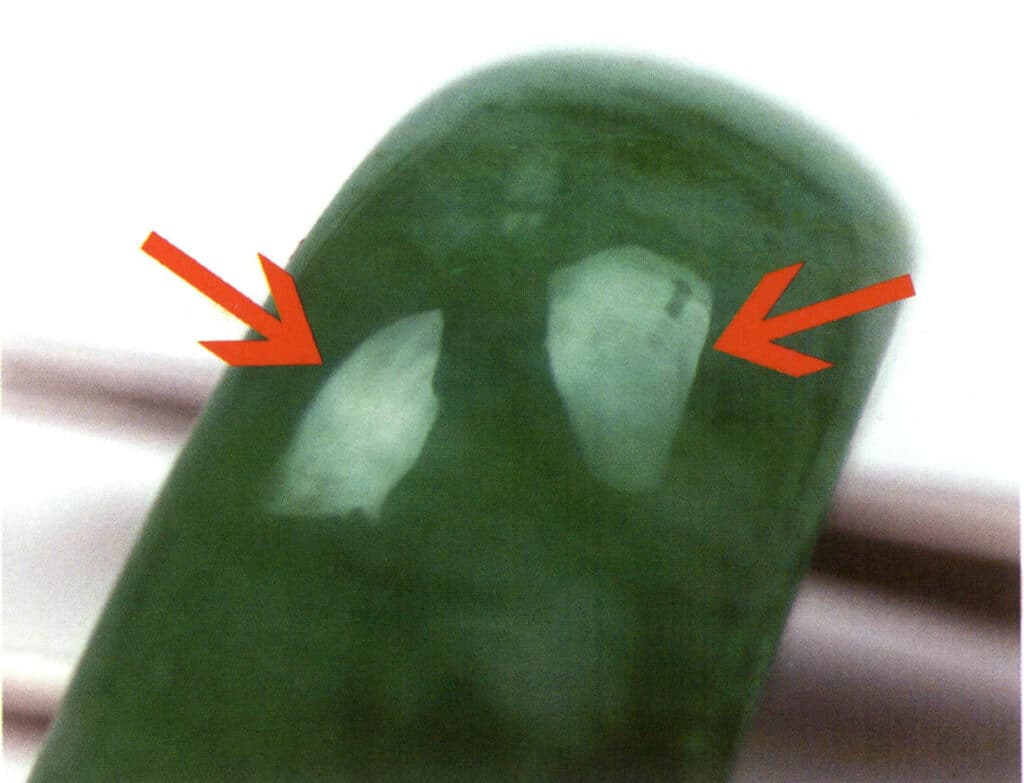
Figure 3-3-11 Jadeite without orange peel effect
4. The relative density of aggregates
The density of aggregates differs from that of crystals; its value is not a fixed number but a fixed range. The density of aggregates is closely related to the types and contents of the constituent minerals. For example, Dushan jade, the main mineral components are plagioclase (anorthite) and zoisite, with minor minerals including green chrome mica, light green pyroxene, yellow-green amphibole, biotite, and a small number of other mineral components. The density of Dushan jade can range from 2.70g/cm³ to 3.09g/cm³.
5. Toughness of aggregates
The phenomenon of gemstones resisting breakage (abrasion, stretching, indentation, cutting) is called toughness.
Toughness is unrelated to the optical properties of gemstones and is also unrelated to cleavage, parting, fracture, hardness, density, and other mechanical properties. It is closely related to the direct bonding between elements and minerals. Generally speaking, the toughness of aggregates is much better than that of crystals, which is why black aggregate diamonds are tougher than ordinary crystal diamonds and even tougher than Jade and nephrite, making them the toughest among all gemstones.
Common aggregate gemstones ranked from strongest to weakest in toughness are black diamonds, nephrite, and Jadeite.
Section V Where do gemstones come from?
More tips: Where do gemstones come from?
The Earth we live on can be seen as a huge sphere composed of various rocks, which are made up of small fragments formed by one or more substances, and these substances are minerals produced by the interaction of different chemical elements.
Natural inorganic gemstones are a beautiful, durable, rare, and processable part of minerals and rocks. Most natural gemstones form the same way as rock minerals, while a small portion of gemstones are unrelated to the Earth, such as the glass in meteorites.
So, where are gemstones found? But, wherever there are rocks, there may be gemstones, as gemstones naturally accumulate within rocks. Locations with a large number of gemstones are referred to as deposits.
1. Rocks
During magma cooling from a molten state to a solid state, some elements arrange themselves in a regular pattern to form crystalline mineral solids, and various minerals gather together to form diverse types of rocks.
Rocks are natural aggregates of minerals with a certain structure and composition formed under specific geological conditions. Mineral aggregates formed by different geological processes make up different types of rocks. The formation and transformation of rocks are closely related to magmatism, sedimentation, and metamorphism within the geological action system.
Igneous rocks, formed by magmatism, include unique gem varieties such as diamonds, obsidian, and agate. Rubrics, sapphires, crystals, and garnets can also be found in other geological processes.
Sedimentary rocks, formed by sedimentation, include unique gem varieties such as Turquoise, malachite, and Jadeite. Most gem varieties can be found in sedimentary deposits, which typically have fewer internal fractures and better quality.
Metamorphic rocks, formed by metamorphism, include unique gem varieties such as Jade, nephrite, serpentine, andalusite, and silicified wood.
2. Mineral Deposits
As products of geological processes, the formation of gems occurs under very complex geological conditions. Based on the nature of geological processes and energy sources, the genesis of gem deposits can be divided into endogenous mineralization, exogenous mineralization, and metamorphic mineralization.
2.1 Endogenous mineralization
Refers to a series of mineralization processes related to magmatism and volcanic eruptions.
Mainly includes magmatic mineralization (gemstones formed include diamonds, pyropes, rubies, sapphires, olivine, moonstone, etc.), pegmatitic mineralization (gemstones formed include rubies, sapphires, garnets, crystals, spinel, tourmaline, topaz, amazonite, etc.), hydrothermal mineralization (gemstones formed include rubies, sapphires, crystals, emeralds, agates, topaz, tanzanite, etc.), and volcanic mineralization (gemstones formed include obsidian, etc.)
2.2 Exogenous mineralization
This refers to mineralization processes formed near the Earth’s surface due to the actions of the sun, water, wind, air, and other organisms.
The types of mineral deposits formed mainly include weathered crust type, sand mine type, and sedimentary type. The weathered crust and sand mine types are secondary deposits, such as opal, Chalcedony, turquoise, malachite, diamond, ruby, sapphire, Jade, nephrite, beryl, garnet, etc.
2.3 Metamorphic mineralization
Refers to the formation of mineral groups (rocks or ore deposits) under the action of internal crustal stress (such as the action of temperature, pressure, magma, hydrothermal, etc.) caused by tectonic movement, so that its material mineral composition, mineral combination, structure and structure changes to form new minerals, rocks or ore deposits, such as jade, garnet, tourmaline, ruby, sapphire, silicified wood and moonstone.





